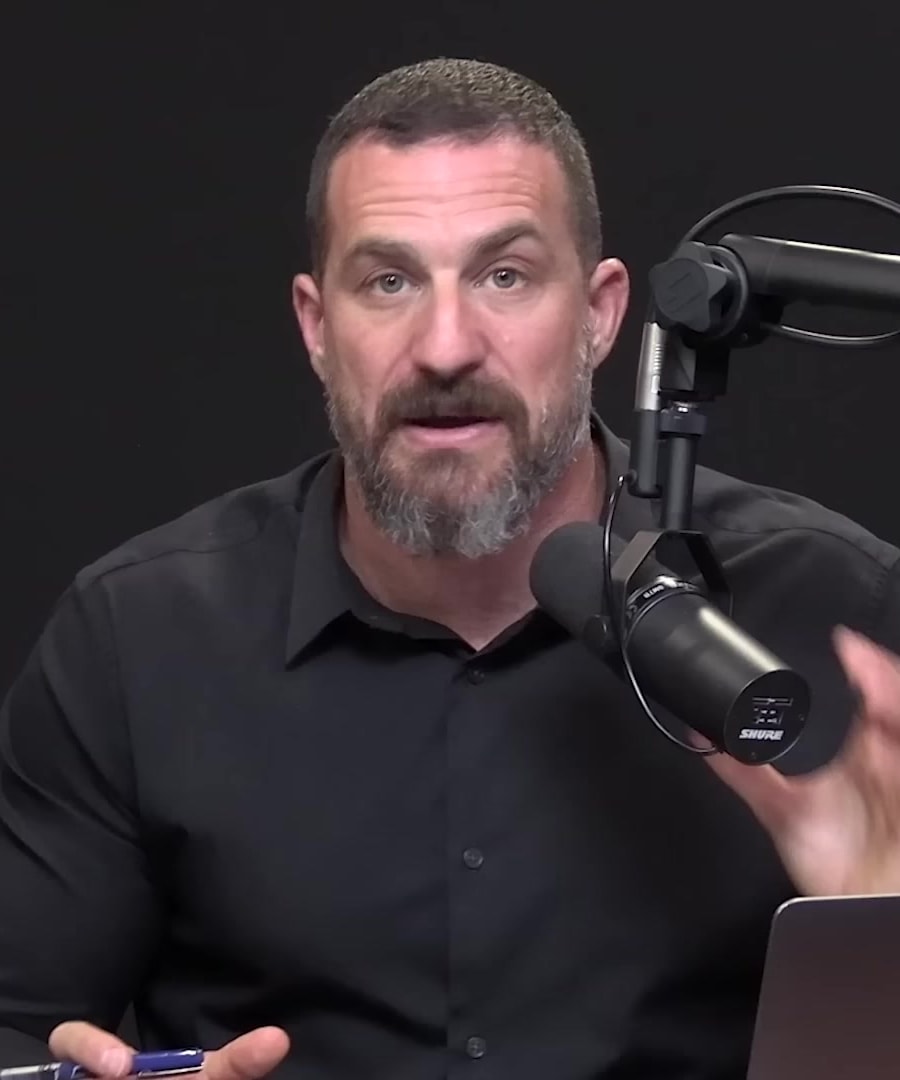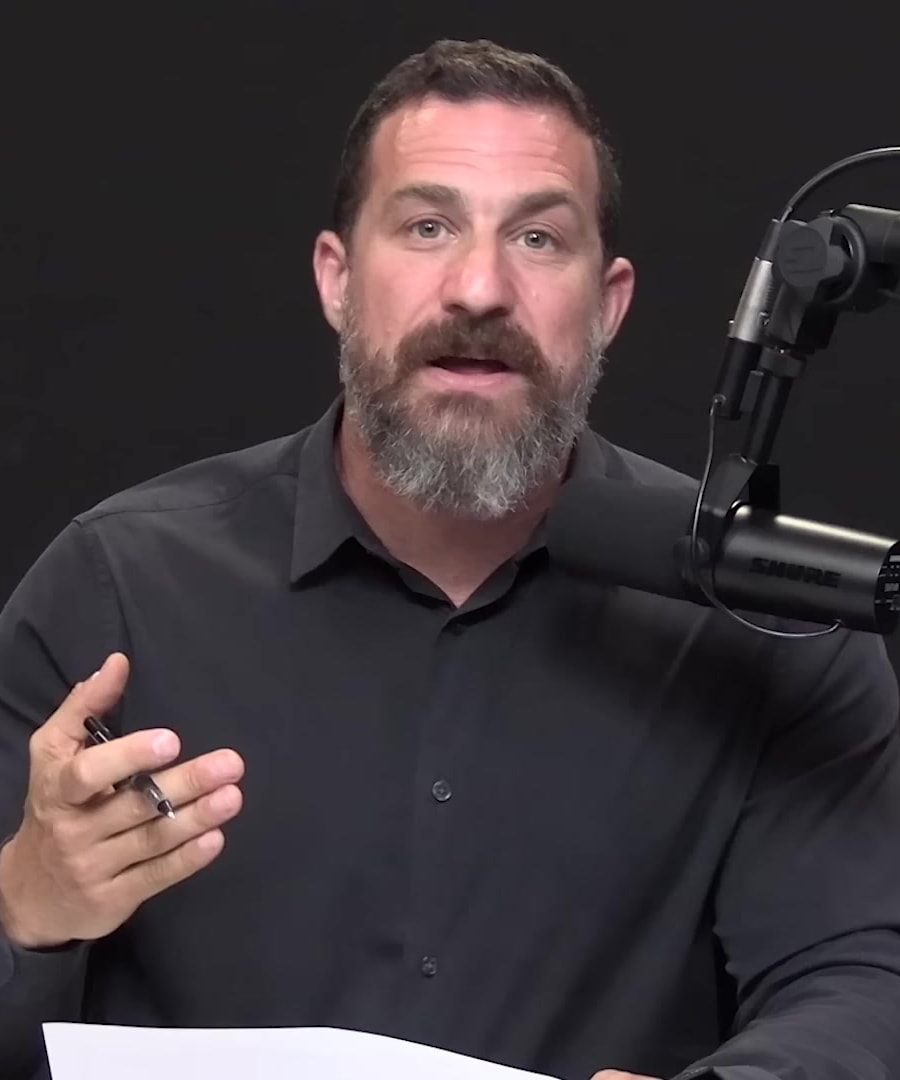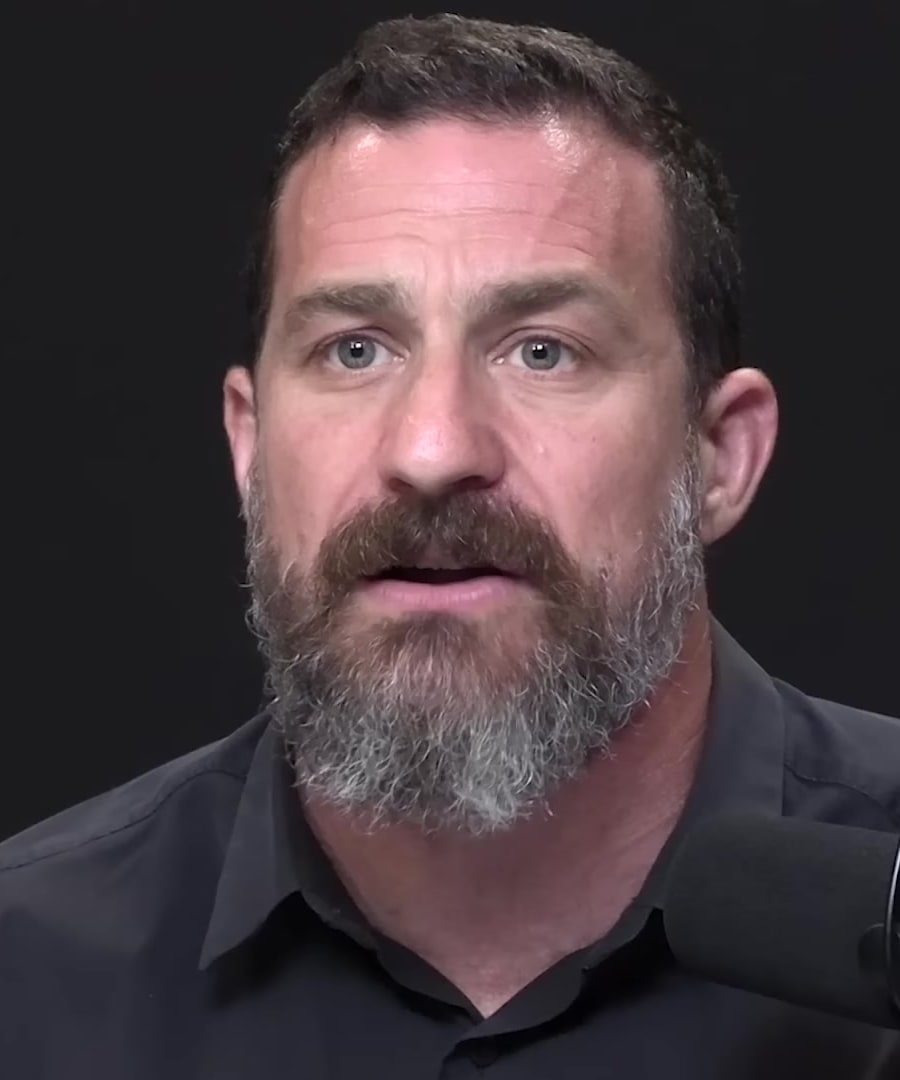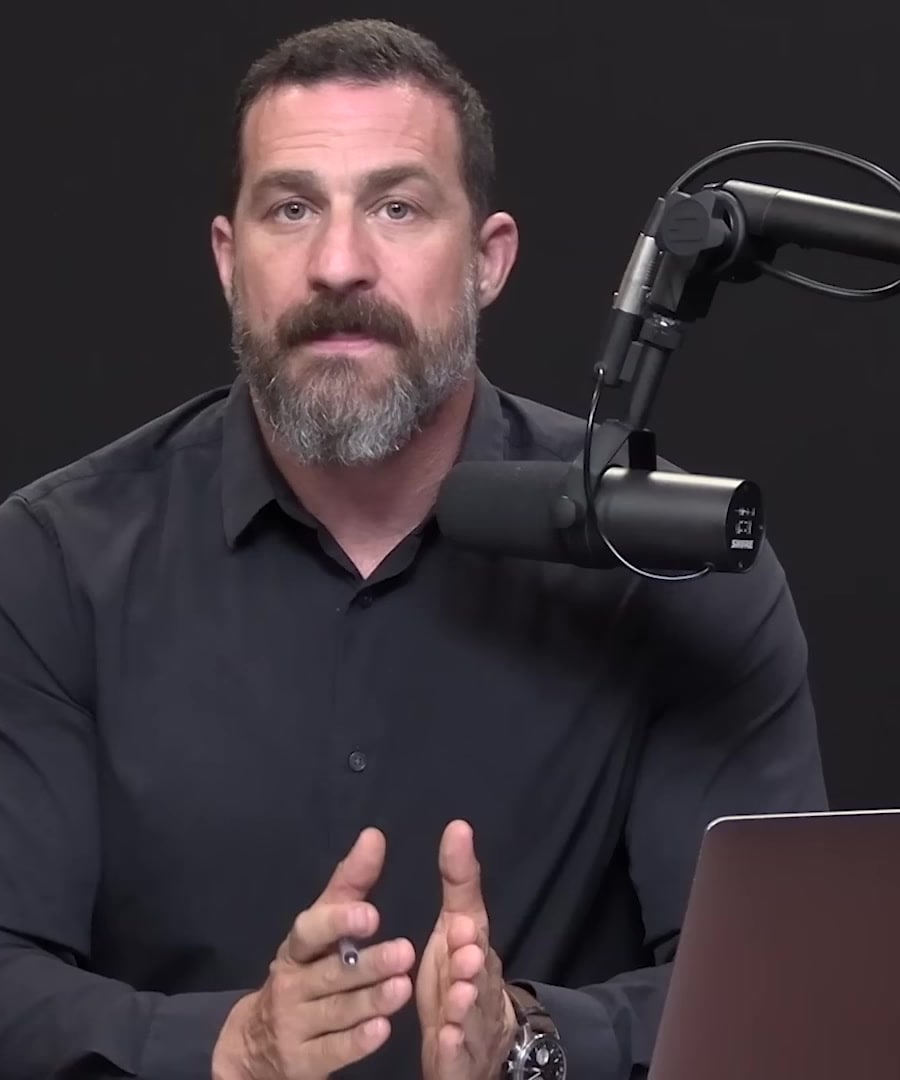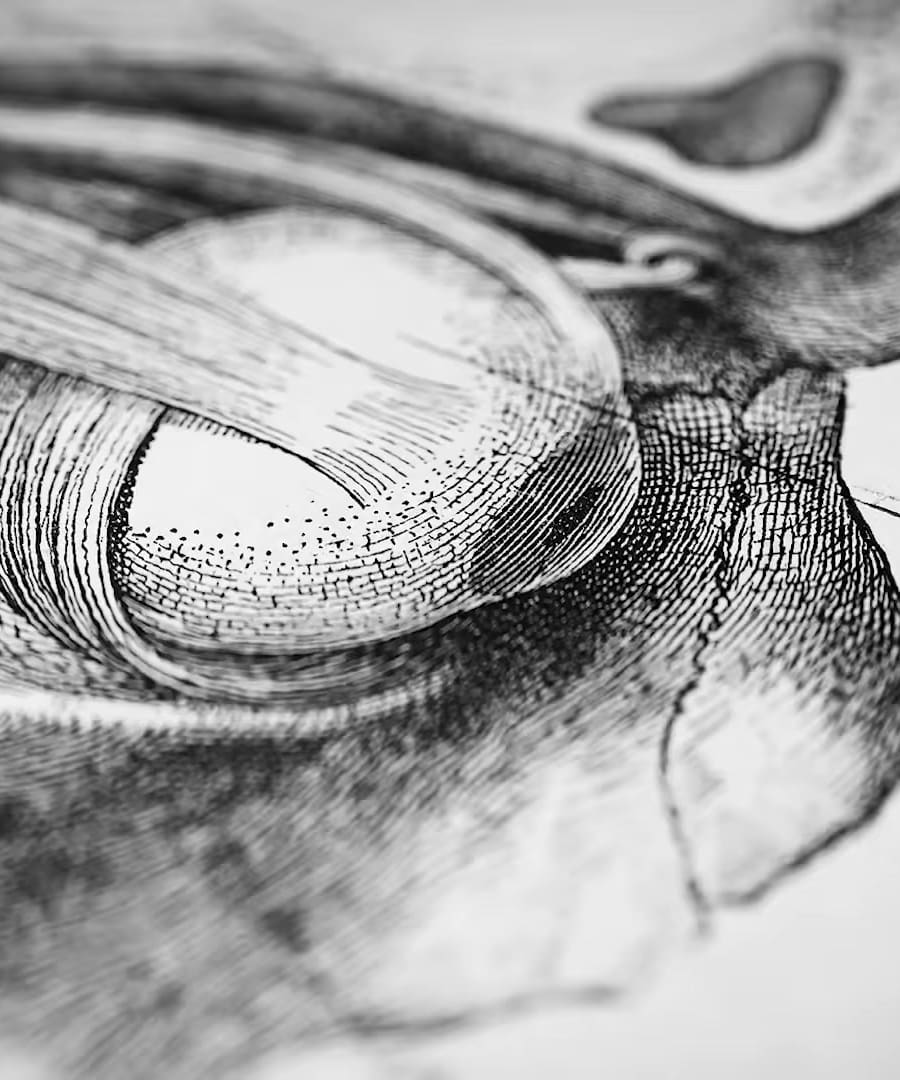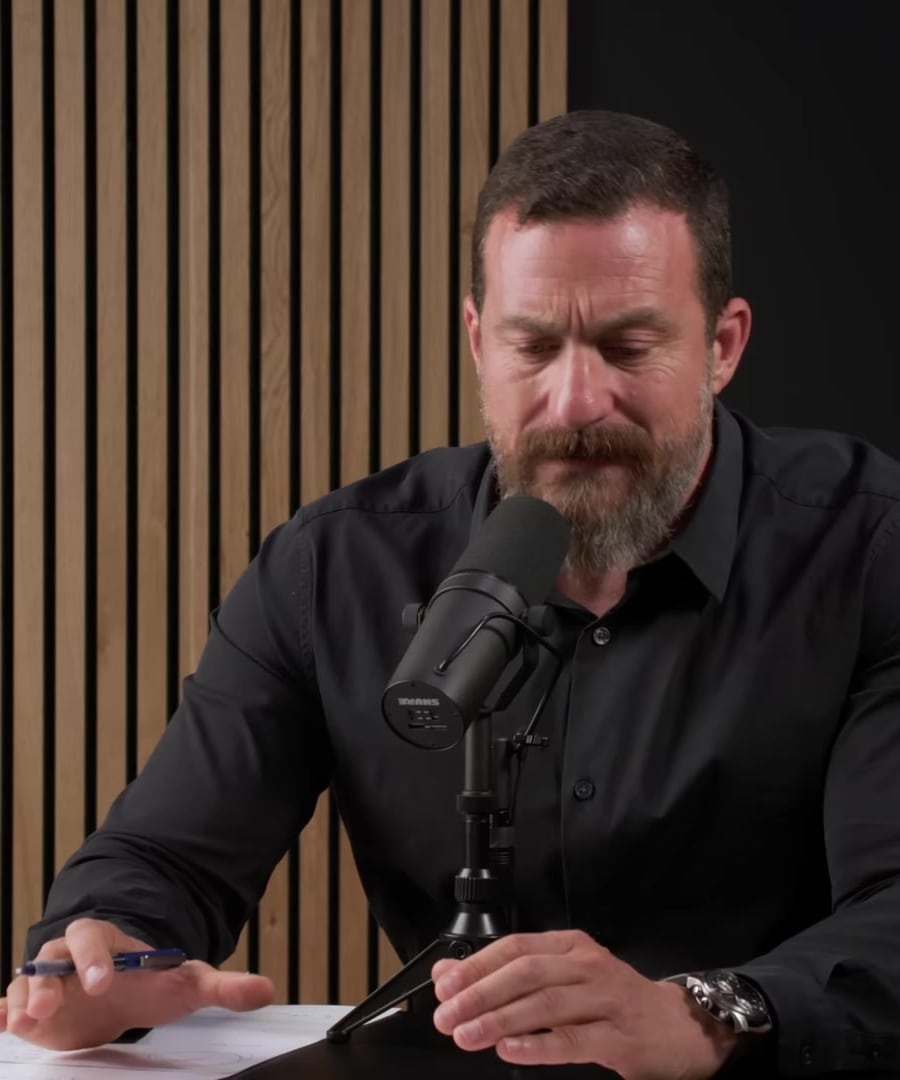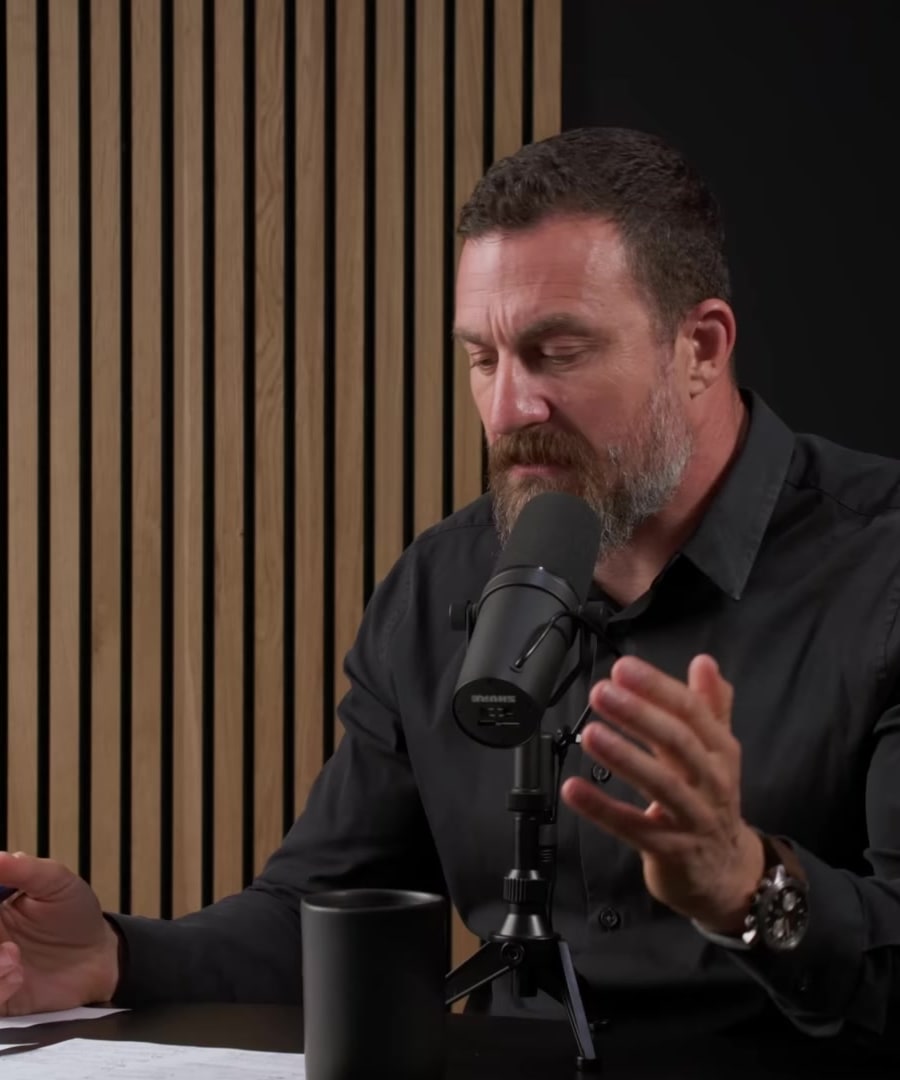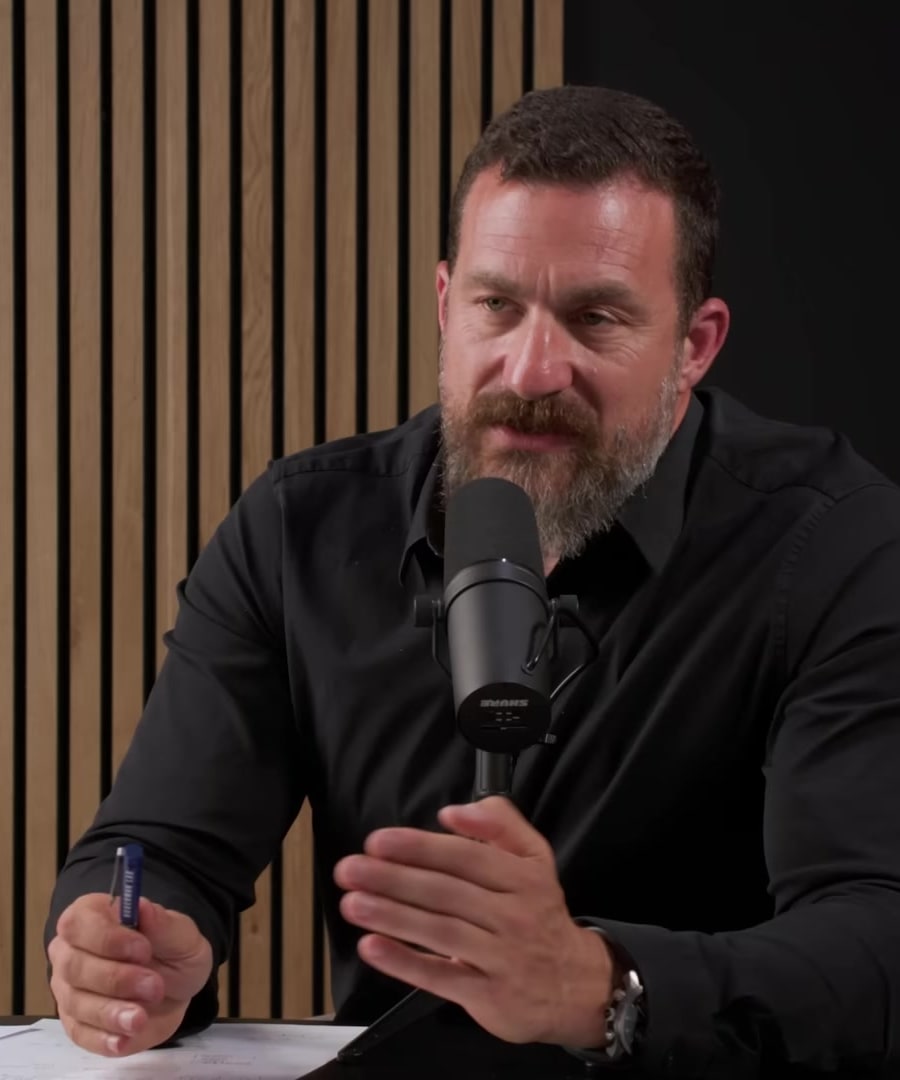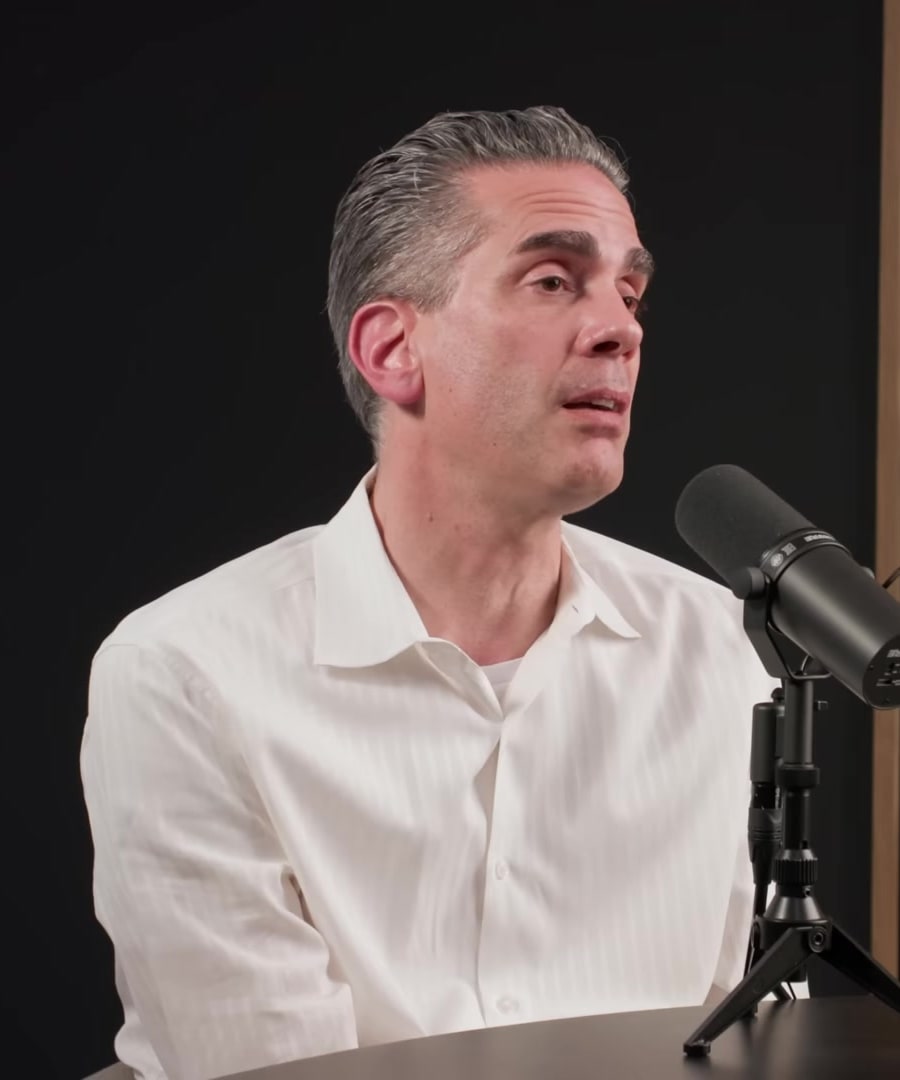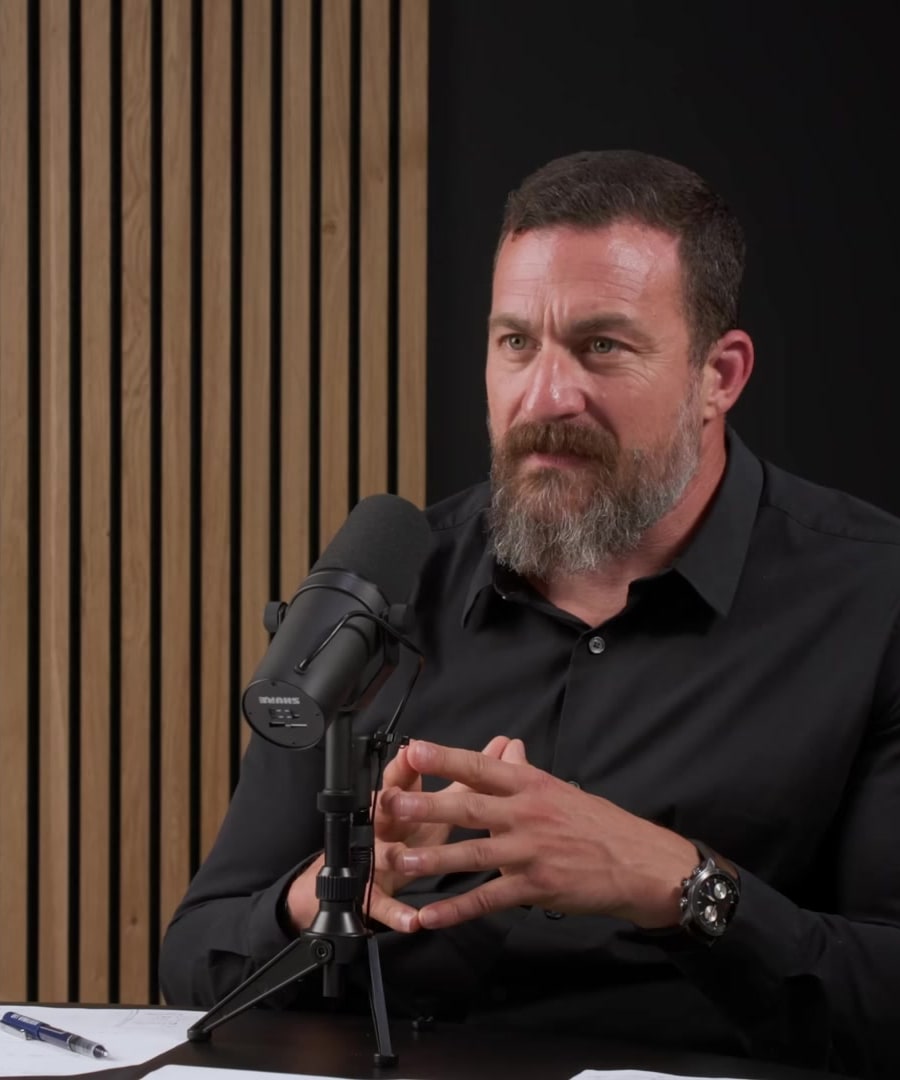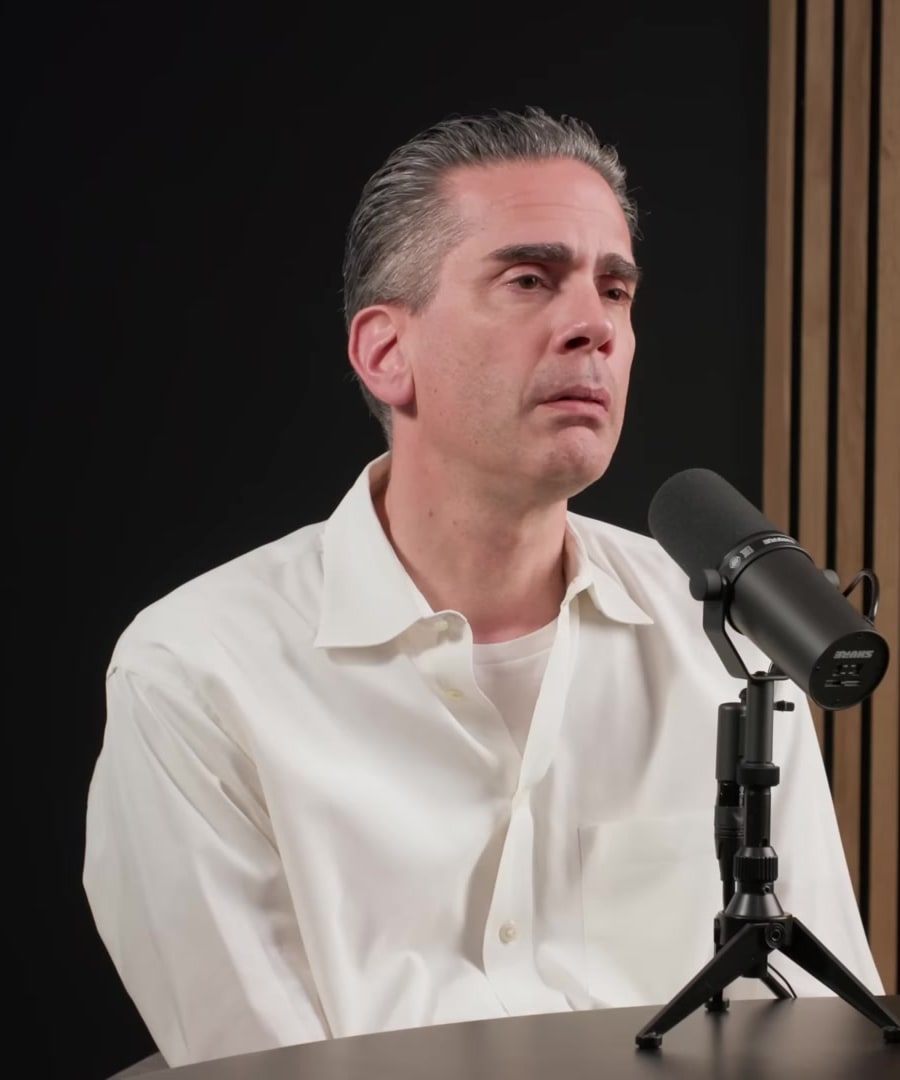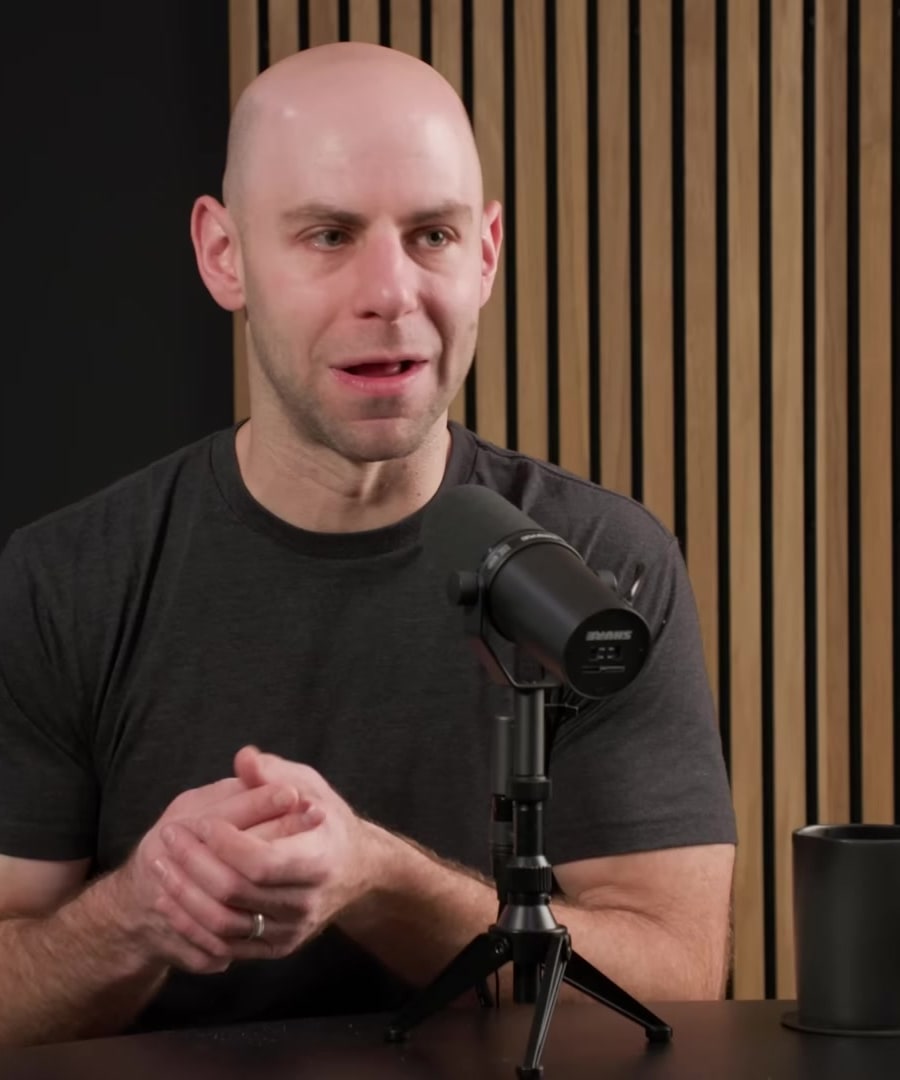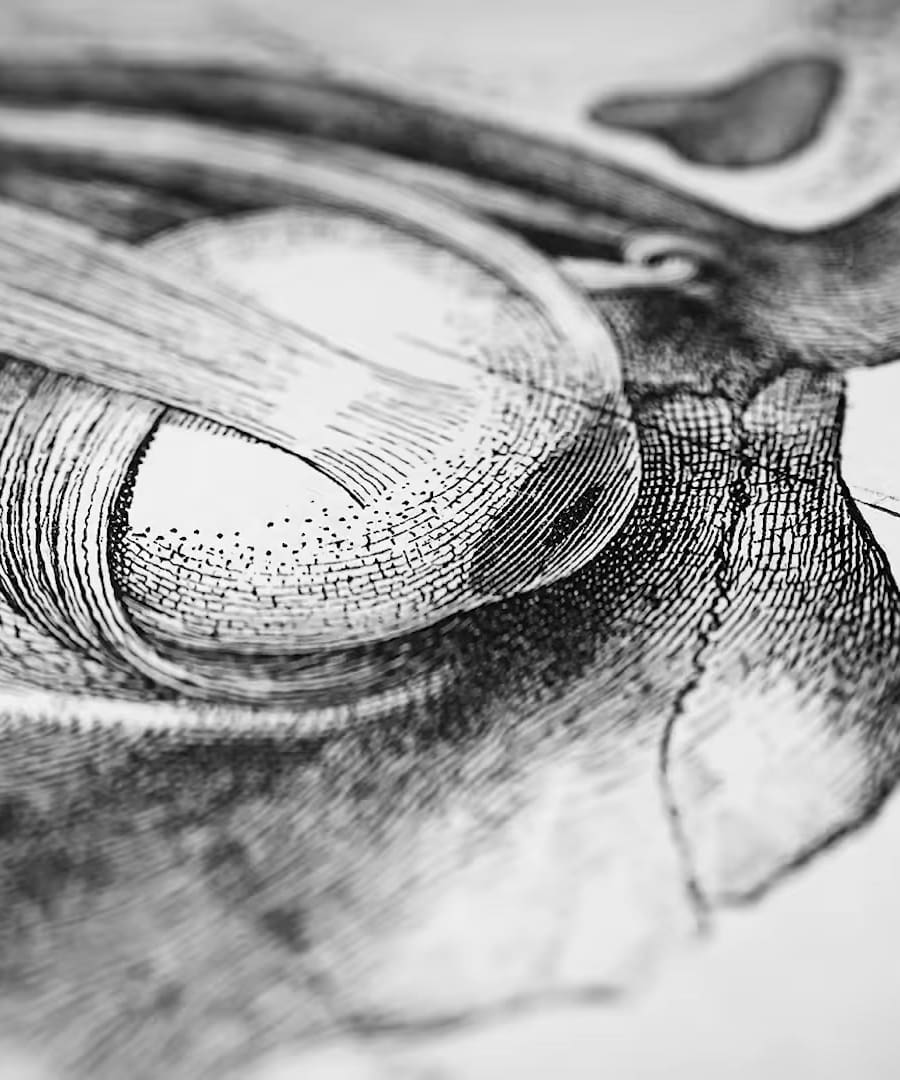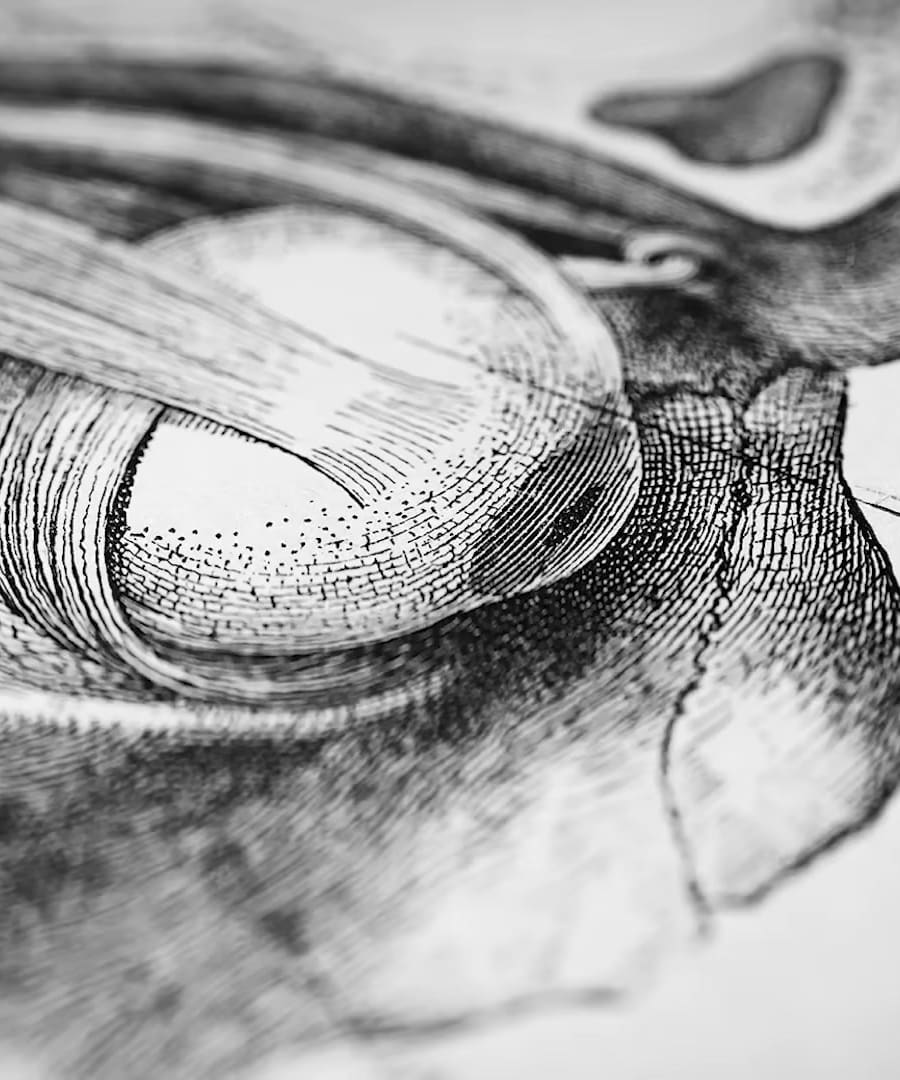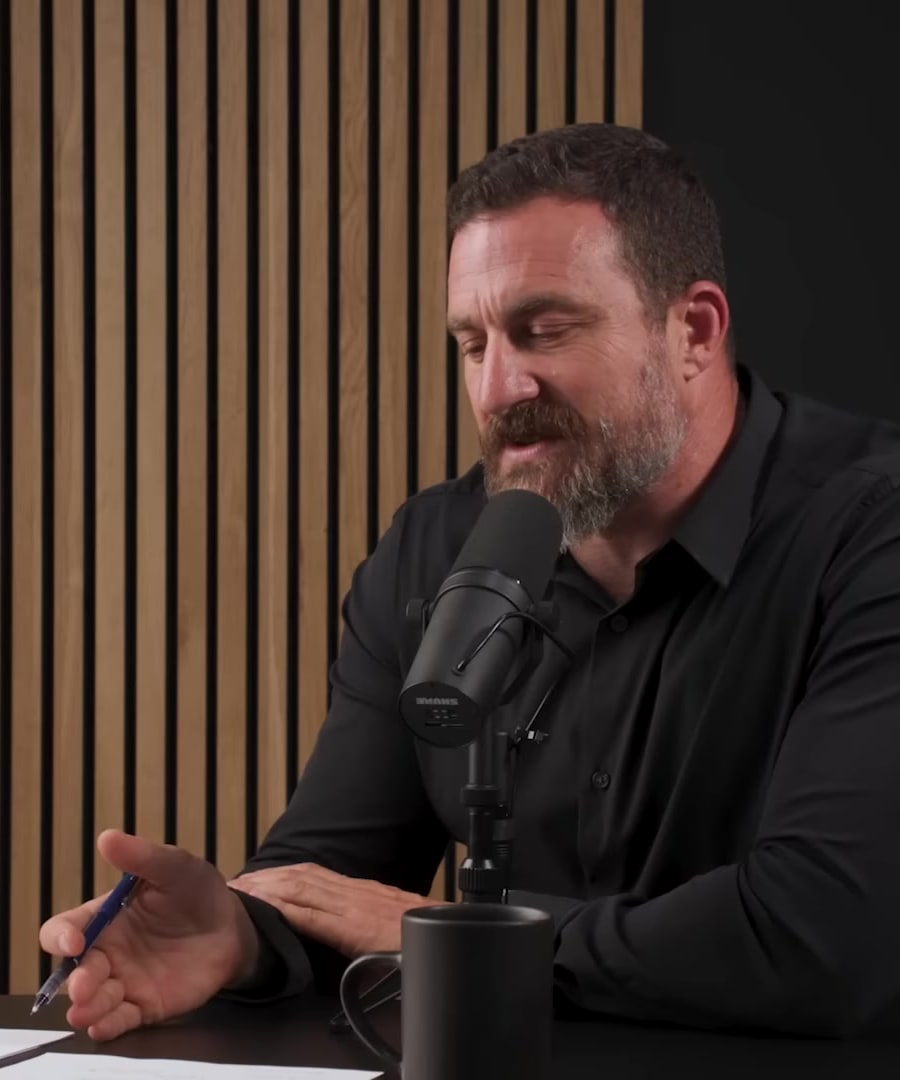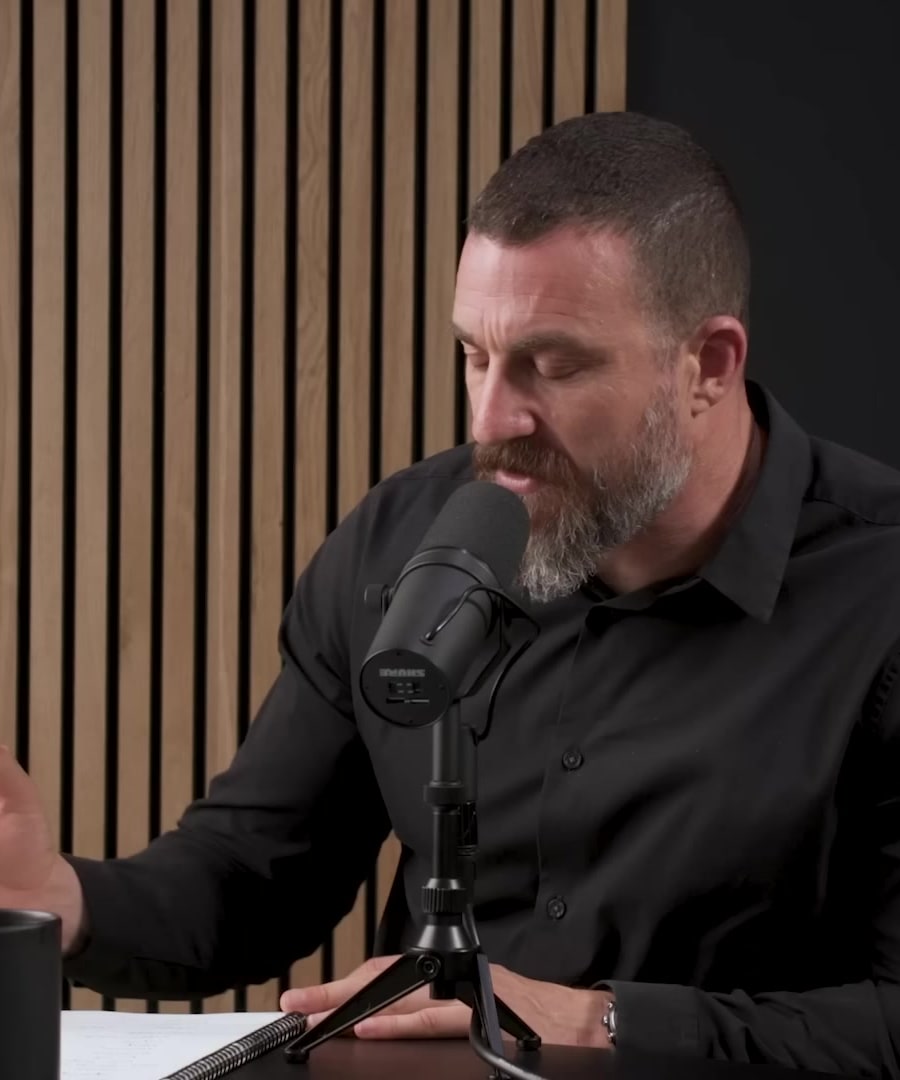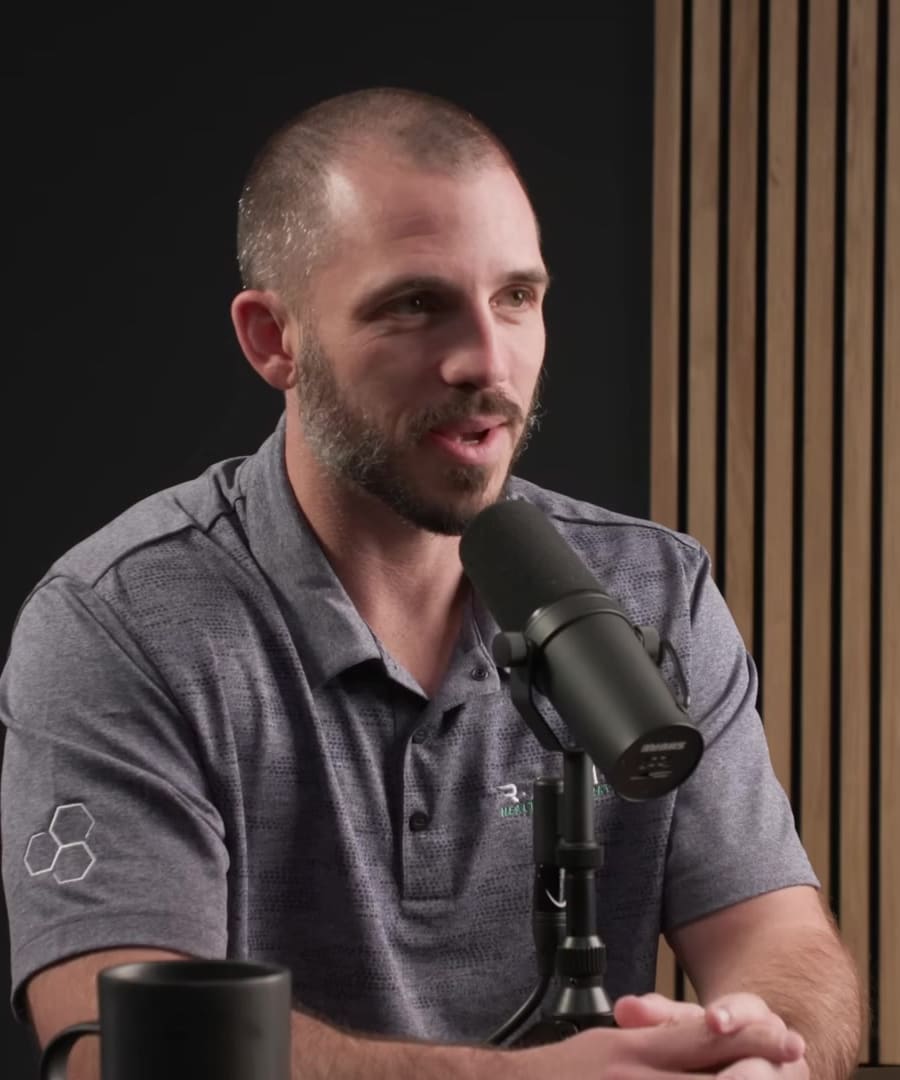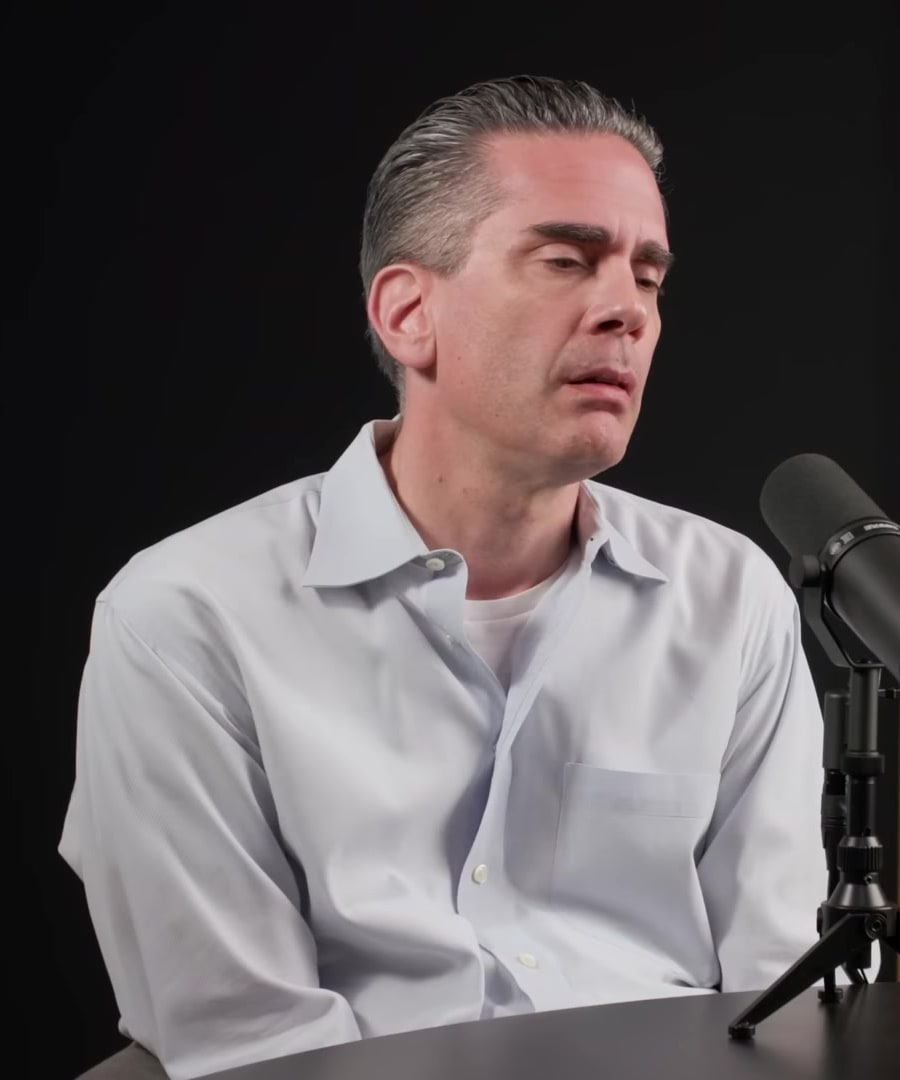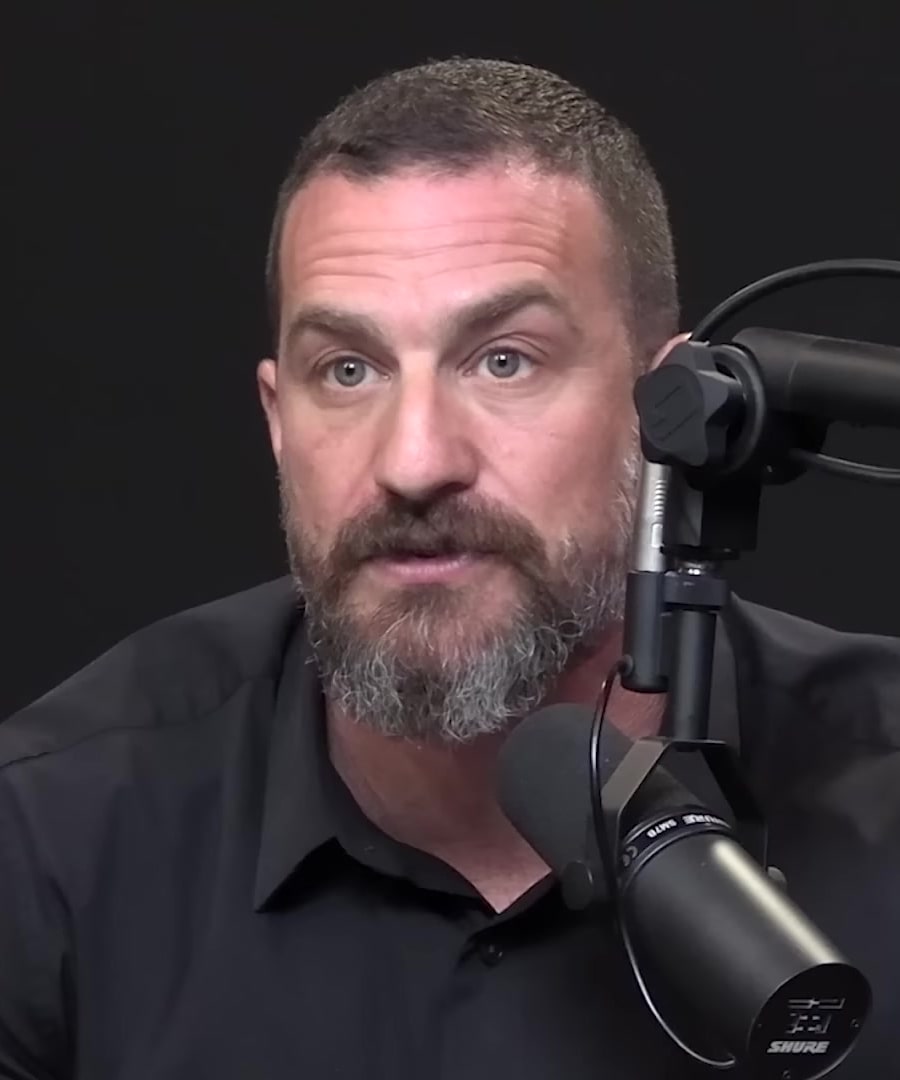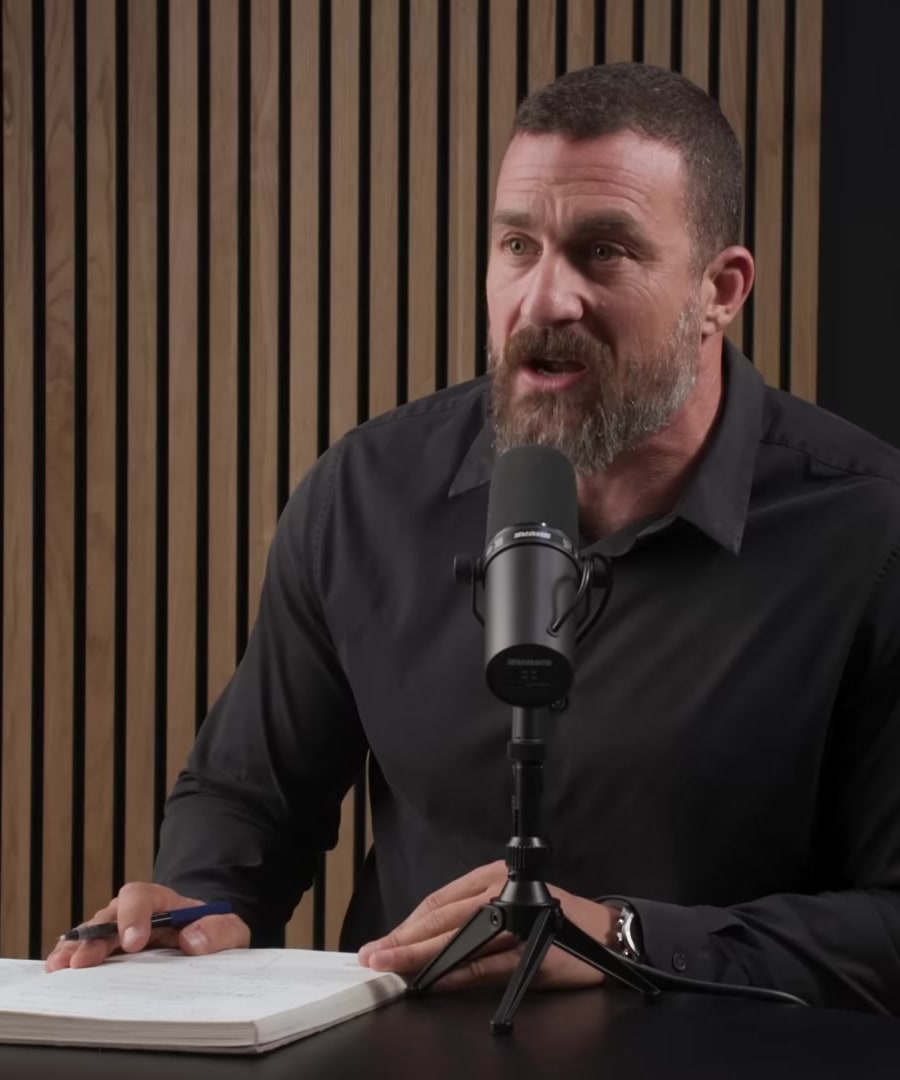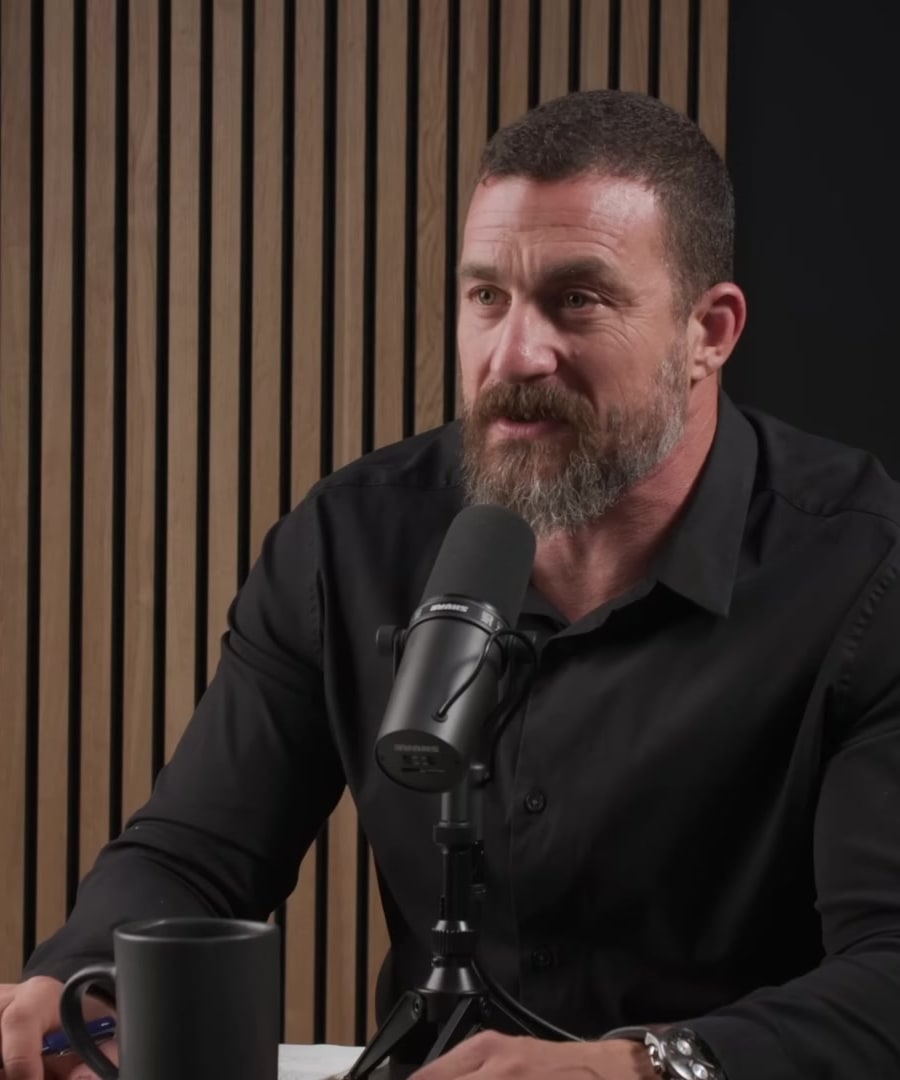What protocols are recommended for improving sleep?
Sources:
To improve sleep, multiple strategies have been discussed on the :
- Use tools like the Timeshifter app for managing jet lag by adjusting light exposure, meal times, and other factors 1.
- Elevate the head of your bed to help with acid reflux and consider myofunctional therapy for snoring or REM sleep issues 1.
- Practice NSDR protocols like hypnosis for sleep, which can improve sleep quality without medication 2.
- Optimize sleeping behavior and get quality sleep most nights, as sleep is the primary modulator for focus and attention 3.
- Test and potentially integrate supplements like Magnesium Threonate, apigenin, or theanine, adding or removing them one at a time to see what helps your particular sleep issues 4 5.
- Use meditation - daily practices can enhance various cognitive functions but should be done at the right time, as meditating too close to bedtime can impair sleep 6.
Additionally, keeping the sleeping environment dedicated to only sleep and sex can markedly improve the ability to fall and stay asleep 1.
As a side note, it's essential to discuss changes to your sleep hygiene or supplementation with a healthcare professional to ensure the suitability for your individual health needs.
RELATED QUESTIONSOutline a sleep hygiene worksheet for me to go through when setting up a new sleep protocol.
While a specific "sleep hygiene worksheet" has not been discussed as such on the , I will create an outline for you based on the sleep improvement protocols mentioned throughout various episodes. Here is a proposed Sleep Hygiene Worksheet outline:
-
Bedtime & Wakeup Consistency:
- Set a fixed wakeup time every day, including weekends.
- Establish a consistent bedtime that allows for 7-9 hours of sleep.
-
Pre-Sleep Routine:
- Engage in a wind-down routine 1-2 hours before sleep. It could include reading, stretching, or other relaxing activities.
- Limit exposure to bright lights and screens before bedtime.
- Consider a hot bath or shower 1-2 hours before bed to initiate the body's temperature drop, aiding the onset of sleep.
-
Sleep Environment:
- Ensure your bedroom is cool, dark, and quiet to promote uninterrupted sleep.
- Invest in a comfortable mattress and pillows.
- Use blackout curtains or a sleep mask, and consider earplugs or white noise if needed.
-
Dietary Considerations:
- Avoid caffeine and other stimulants several hours before bedtime.
- Limit heavy meals and excessive liquids close to bedtime.
- Avoid alcohol close to bedtime as it can disrupt sleep patterns.
-
Physical Activity:
- Include regular exercise in your daily routine, but not within 2-3 hours of bedtime.
-
Relaxation Techniques:
- Practice relaxation techniques such as meditation, deep breathing, or progressive muscle relaxation.
- Explore NSDR (non-sleep deep rest) practices, like yoga nidra or self-hypnosis, if falling asleep is difficult.
-
Limit Bed Activity:
- Restrict activities in bed to sleep and intimacy. Avoid TV, work, or extended phone use in bed to strengthen the association between bed and sleep.
-
Daylight Exposure:
- Spend time outdoors in natural light, especially in the morning, to help regulate your sleep-wake cycle.
-
Supplements (as considered with a healthcare provider):
- Contemplate if sleep supplements like magnesium, apigenin, or theanine could be helpful. Begin with the smallest effective dose.
-
Journaling:
- Keep a sleep diary to record sleep patterns and how you feel each day upon waking. Make notes on what helps and what hinders your sleep.
Remember to consult a healthcare professional before implementing new health protocols and to adjust this worksheet as necessary based on your individual needs and any new information from the .
RELATED QUESTIONS-
Now list out the podcast episodes to listen to about sleep.
Here's a list of episodes that discuss sleep and related topics:
- (Published on Aug 7, 2022)
- (Published on Aug 1, 2021)
- (Published on Jan 11, 2021)
- (Published in 2024)
- (Published on Jan 18, 2021)
- (Published on Feb 14, 2023)
Listening to these episodes will provide comprehensive insights into improving sleep, understanding its biology, and optimizing your sleep protocol from the knowledge shared by and guests.
RELATED QUESTIONSThank you. Now in paragraph form, describe why sleep is important and why it should be prioritized for mental health.
Sources:
Sleep holds paramount importance for mental health because it enables the brain to process and consolidate experiences from the day into memories, facilitating learning and the ability to cope with emotional events. Moreover, adequate and high-quality sleep regulates mood, aids in stress management, and promotes emotional resilience. and his guests on the frequently emphasize the foundational aspect of sleep, describing it as the bedrock of mental and physical health, far exceeding the benefits from any nootropic or prescription drug in terms of fostering mental acuity and physical vigor.
A regular and consistent sleep routine is key for avoiding disruptions in metabolism related to mood, energy regulation, and sleep quality itself. Lack of sleep has been linked with heightened anxiety, depression, and irritability, signifying that prioritizing sleep can lead to better emotional regulation and a healthier mental state. More specifically, striving for a regular sleep schedule maintains an optimal balance of slow-wave sleep (deep sleep) and REM (rapid eye movement) sleep, both crucial for emotional processing and cognitive function.
Furthermore, , an expert on sleep and its effects on the brain, alongside , also highlight the association between regular sleep and improved mental, physical health, and performance. Poor sleep has repeatedly been connected to various health problems, including metabolic syndromes like obesity and type two diabetes, which often lead to or exacerbate mental health issues due to the interconnected nature of physiological and psychological health.
Overall, prioritizing sleep enhances brain function, mood stability, learning, and memory — all of which are integral to mental health. The insight offered by drives home the point that to maintain and improve mental health, sleep should not be an afterthought but a central component of daily life 1 2 3 4 5 6 7.
RELATED QUESTIONScontinue
Sources:
Sleep is fundamental to mental health, serving as the bedrock upon which our physical health, mood regulation, cognitive performance, and overall well-being are built. According to , consistent and quality sleep each night is crucial for mental health because it affects neurotransmitter production, hormone regulation, and autonomic function—all vital in mood and energy regulation. A regular sleep routine is also strongly linked to improved sleep quality, facilitating the right balance of slow-wave (deep) sleep and REM sleep, which are essential for emotional processing and mental balance 1.
Moreover, stresses that not getting sufficient or quality sleep can lead to dysregulation of metabolic pathways, affecting metabolism, and thus, indirectly influencing mental health 2. He emphasizes the importance of lifestyle factors and supplementation, such as therapy and sleep environment optimization, in supporting mental health by providing the underpinning stability and regulation needed for dealing with fears, trauma, and overall emotional well-being 3.
The power of therapy is also noted to be on par with regular exercise, providing support and insights that can improve emotional life, relationships, and professional goals. This holistic approach to addressing mental health reflects the interconnectivity of sleep with other aspects of our daily life 4.
Therefore, sleep should be prioritized for mental health due to its sweeping effects on brain function, emotional regulation, and physiological health, creating a foundation upon which a healthy, fulfilling life can be built.
RELATED QUESTIONSLove it. Outline a sunshine worksheet for me to go through when making sure I'm optimizing sunlight. Include information on why sunlight is valuable.
Sources:
To optimize your sunlight exposure for the numerous health benefits it entails, here is a "Sunshine Worksheet" based on the knowledge from the :
-
The Goal of Sunlight Exposure:
-
Morning Sunlight:
-
Duration and Intensity :
-
Midday Sunlight:
- Continue seeking bright light at intervals for wakefulness and metabolic health throughout the day 1.
-
Late Afternoon/Evening Sunlight:
- Get exposure to natural light in the late afternoon to help with the wind-down process for bed 5.
-
Considerations for Weather Conditions:
-
Safety Measures:
By following this worksheet, you will optimize your exposure to sunlight, taking advantage of its health benefits while ensuring safety and practicality.
RELATED QUESTIONS-
Can you tell me more about the benefits of sunlight?
Sources:
Sunlight provides several significant benefits as discussed by in various episodes of the podcast:
- Circadian Rhythm Regulation: Sunlight exposure, especially in the morning, helps set your circadian rhythms, leading to improvements in mood, focus, alertness, and better sleep at night 1.
- Metabolic Health: Getting sunlight in the eyes early in the day has positive effects on metabolism, either directly or through better sleep 1.
- Mental Health: Exposure to bright light throughout the day has been shown to improve mood and mental health 2.
- Protection Against Artificial Light: Exposure to sunlight in the late afternoon and evening can protect the nervous system from the negative effects of artificial light exposure later at night 3.
- Boost Testosterone and Estrogen: Sunlight on the skin can trigger increases in hormones like testosterone and estrogen, which are associated with mood elevation, increased libido, and overall wellbeing 4.
- Dopamine Release: UVB (ultraviolet blue) light from the sun stimulates a pathway involving the molecule P53 in the skin, leading to dopamine release in the brain and body. This can lead to feelings of pleasure and increased energy 4.
These benefits underscore the importance of responsibly incorporating sunlight into your daily routine for both physical and mental wellness. Always remember to avoid sunburns and harmful exposure by taking appropriate precautions, like timing your sunlight exposure and using sunscreen as needed.
RELATED QUESTIONSTry again, putting it into paragraph form.
Sources:
Sunlight is a crucial component for various bodily rhythms and health benefits as explained by on the . Receiving morning sunlight helps regulate the circadian rhythm, crucial for mood, focus, and alertness, and can improve nighttime sleep and metabolism. This regulation of circadian rhythms is primarily achieved by getting sunlight early in the day; cloud cover or artificial light simply isn't as effective 1. Sunlight exposure also sets the cortisol rhythm, essential for alertness during the day and a proper sleep cycle at night 2.
Sunlight has benefits for mental health, with bright light exposure known to enhance mood and well-being. This is due to the activation of specific cells in the eyes by bright light, which then project to brain areas that regulate mood 3. Moreover, for overall eye health, some sunlight exposure is beneficial as it can help with maintaining vision. However, proper eye protection and caution are advised to prevent damage like cataracts 4.
Lastly, discusses the importance of aligning one's internal clock with natural light. The visual system not only helps us see but also informs our brain and body about the time of day. He recommends seeking out the sun or bright light early in the day and throughout as safely possible to trigger the positive biological effects of light, such as waking up the brain and setting circadian rhythms 5. While artificial bright lights may suffice when sunlight isn't available, they are not nearly as effective in setting these biological mechanisms, underscoring the unique value of natural sunlight 6.
RELATED QUESTIONScontinue
Sources:
emphasizes the significant influence of sunlight on various aspects of our biology. Beyond circadian rhythm regulation, sunlight, particularly UVB light, plays a vital role in regulating hormones such as beta-estradiol, progesterone, and testosterone in both men and women. A study mentioned by Dr. Huberman found that approximately 30 minutes of outdoor UVB sunlight exposure a few times a week, with appropriate clothing and without getting sunburned, leads to increases in these hormones, which are associated with mood and libido improvements 1 2.
The persistence of ancient circadian mechanisms within modern environments was highlighted, revealing that despite changes in societal structure like work schedules, natural light remains a crucial component for aligning our intrinsic circadian rhythms, supporting mental health, and possibly affecting the desire to mate 3. Furthermore, getting as much bright light exposure as possible throughout the day, including late afternoon sunlight, can protect against the negative effects of artificial light at night, benefitting our wakefulness and circadian rhythms 4.
Dr. Huberman suggests that early morning sunlight exposure immediately after waking is key. On non-overcast days, 10 minutes of sunlight is recommended, and on overcast days, as much as 20 to 30 minutes. This morning sunlight can significantly boost mood, focus, and alertness, and subsequently improve sleep quality at night. Even in areas with an overcast climate, there's still enough natural light to benefit from 5. For those struggling with mental health issues, the effect of light extends beyond circadian regulation to include direct pathways to mood-controlling brain regions 6. The seasonality of light availability also seems to correlate with testosterone levels and sexual passion 7.
In essence, Dr. Huberman underscores the persistent and robust effects of sunlight on mental and physical health, including hormonal cycles, mood regulation, and overall well-being.
RELATED QUESTIONSIn paragraph form, explain the goal and outcomes of sunshine exposure.
Sources:
The goal of sunshine exposure is to harness its myriad biological benefits, which extend far beyond just providing light and warmth. As expressed by , sunlight can profoundly enhance mental and physical health by influencing wakefulness, mood, and hormone regulation. Sunshine stimulates neurons in the eye that signal the brain to suppress melatonin during the day, which contributes to higher levels of hormones like testosterone and estrogen, thus affecting mood and libido 1 2. This suppression of melatonin is important for maintaining a healthy circadian rhythm, which is foundational for good mental health, mood, and cognitive function.
The outcomes of regular sunlight exposure are significant and diverse. Morning light, in particular, aligns our circadian rhythms to promote wakefulness and alertness during the day, as well as improved sleep at night 1. This is due to the fact that light exposure triggers a strong cortisol response early in the day, anchoring wakefulness and combating depression and anxiety 1. Additionally, UVB exposure to the skin activates pathways such as p53, which in turn modulate hormones like beta-estradiol, progesterone, and testosterone 2. Exposure to sunlight also increases dopamine, leading to enhanced mood and feelings of passion, with some studies showing significant increases in testosterone and estrogen levels after regular sun exposure 3.
In essence, the goal of sunlight exposure is to synchronize our hormonal and circadian rhythms with the natural environment, optimizing our mental clarity, mood, and overall physiological health. The outcomes, as detailed by , include not only circadian benefits and better sleep, but also improved hormonal balance and elevation in general well-being, thereby showcasing the powerful impact that natural light has on our body's systems.
RELATED QUESTIONSWhich podcasts are helpful for learning about the benefits of sunlight?
For learning about the benefits of sunlight, the podcast is an excellent resource. Hosted by , this podcast delves into a wide range of topics related to neuroscience and its impact on our daily lives, including the science of how sunlight affects mental and physical health. Through various episodes, Dr. Huberman discusses the critical role of sunlight in regulating circadian rhythms, hormone levels, and overall well-being. The Huberman Lab podcast features discussions with renowned experts that can provide in-depth knowledge and insights into how sunlight and other aspects of our environment can optimize health and performance.
RELATED QUESTIONSCreate a worksheet on the pillar of health titled: Relationships with others & self.
Sources:
Relationships with Others & Self Worksheet
Personal Reflection
- Agency & Gratitude Inventory: Reflect on your sense of personal agency—the ability to act and make choices in your life—and the feelings of gratitude you have. List three ways you currently exercise your agency and three things you're sincerely grateful for in your relationships with others and with yourself.
- Generative Drive Exploration: Consider your intrinsic motivation and desire to create and contribute to your own life and those around you. Journal about one aspect of your life where your generative drive is strongest and one where you'd like to improve it 1.
Inquiry and Understanding
- Forms of Inquiry: Write down three 'better' questions you can ask about your current relationships and one question you can ask yourself to improve the understanding of these relationships.
- Self-Exploration: Spend some time to explore the 'cupboards' under the pillars of your structure and function of self. Note any discoveries or insights about how you interact with others and yourself 2.
Boundaries and Mentalization
- Healthy Boundaries Assessment: Define and write down the boundaries you need for different types of relationships (intimate, social, professional, etc.). Reflect on a recent situation where you set a boundary and how it affected your self-perception and the relationship 3.
- Mentalization: Imagine a recent interaction you had with someone. Write down what you think the other person was feeling and thinking during that interaction. Reflect on how this exercise impacts your understanding of the relationship and your own emotional responses 4.
Striving and Empowerment
- Striving: Identify and write down your strivings in your relationships. Consider if these strivings align with your values and beliefs, and how they either support or hinder your relationships with others and with yourself.
- Empowerment: Reflect on how you feel empowered within your relationships. List instances where you've felt a strong sense of empowerment and how it has manifested in your interaction with others 5.
Using this worksheet, you can gain insight into your relationships with others and yourself, uncover areas for growth, and strengthen your mental health and well-being. Remember, these reflections are for your personal development, and the goal is to foster a deeper understanding of your own mental processes and how they influence your interactions with others.
RELATED QUESTIONSNow create an example of how someone might write when filling this same worksheet out.
Sources:
Example of Completed Worksheet: Relationships with Others & Self
Personal Reflection
- Agency & Gratitude Inventory:
- Agency: Choosing to start my day with exercise, speaking up in meetings at work, deciding what I commit my free time to.
- Gratitude: Grateful for the support from my partner, thankful for my friend's sense of humor that lifts my spirits, appreciate my own resilience in dealing with challenges.
Inquiry and Understanding
- Forms of Inquiry:
- What needs do my significant relationships fulfill in my life?
- How can I contribute to the growth of my relationships?
- What patterns have I observed in my relationships, and what do they signify?
- Self-Question: How do I typically react to stress in relationships, and why?
Boundaries and Mentalization
- Healthy Boundaries Assessment:
- Intimate: I need personal time to pursue my hobbies without feeling guilty.
- Social: I choose when and how I engage in social media interactions.
- Professional: I refrain from responding to work emails outside of normal work hours.
Striving and Empowerment
- Striving: In relationships, I’m striving for deeper connections and greater vulnerability. I sometimes hold back out of fear, but I know honest dialogue can strengthen bonds.
- Empowerment: Felt empowered when I negotiated my work boundaries. Felt strong asserting my need for a work-life balance, which led to respect from colleagues.
This mock worksheet illustrates how someone might utilize self-reflection to enhance their relationships with others and with themselves, inspired by insights from on the and guests like and . Personal examples echo the idea that self-exploration and understanding personal strengths lead to gratitude and a sense of agency 1 2.
RELATED QUESTIONS- Agency & Gratitude Inventory:
Thank you. Now write one paragraph explaining the value of this worksheet.
Sources:
This worksheet serves as a practical tool for self-examination and improvement, emphasizing introspection and the framing of life experiences in a constructive way. By offering prompts for agency, gratitude, inquiry, boundary setting, and reflection on relationships, it encourages individuals to analyze their behaviors and interpersonal dynamics. Adopting this mindful approach can lead to greater self-awareness, healthier relationships, and an increased sense of well-being. The worksheet embodies the principle that self-awareness is foundational for personal growth, as discussed by and on the 1 2. Through structured self-reflection, individuals can make informed decisions and adopt habits that enhance their mental health and overall life satisfaction.
RELATED QUESTIONSCreate a new worksheet focused on relationship with others. Include an informative paragraph at the beginning, explaining the purpose and value of the subsequent questions.
This worksheet is designed to promote deeper understanding and healthier dynamics in your relationships with others. It revolves around personal reflection and communication, aiming at fostering empathy, addressing conflicts constructively, and nurturing meaningful connections. Through thoughtful examination of your interactions, you can identify patterns, understand different perspectives, and cultivate behaviors that contribute to fulfilling and supportive relationships. The questions provided will help you gain insights into your relationship strengths, areas for improvement, and the impact of your actions on others, thereby enabling growth and positive change in how you connect with those around you.
Relationship With Others Worksheet
- Identifying Personal Values: What are your core values, and how do they influence your relationships with others?
- Reflecting on Communication: Think about a recent conversation with someone close to you. Did you both feel heard and understood? Why or why not?
- Conflict Resolution: Recall a recent conflict you had. What strategies did you use to resolve it, and what would you do differently next time?
- Empathy Practice: Describe a situation where you made an effort to see things from another person's perspective. How did that affect the interaction?
- Supportive Behaviors: In what ways do you actively show support and care in your relationships?
- Boundaries: How do you set and respect boundaries? Give an example of a boundary you have successfully established.
- Giving and Receiving Feedback: How comfortable are you with giving and receiving constructive feedback? Provide an instance where this played a key role in a relationship.
- Gratitude Expression: What methods do you utilize to express gratitude towards those in your life? Cite a recent example.
- Personal Growth Influence: How have your relationships with others contributed to your personal growth?
- Future Goals for Interpersonal Relationships: What specific goals do you want to set for improving your relationships moving forward?
The purpose of these introspective questions is to inspire personal growth within the context of the relationships you hold. Each question is a stepping stone towards a more profound comprehension of the complex interplay between self-awareness and social interactions, which is crucial for fostering healthy and rewarding relationships.
RELATED QUESTIONSThank you! Now create a similarly formatted worksheet for Relationship with self.
Sources:
This worksheet is intended to foster a positive and nurturing relationship with yourself. Self-relationship is the foundation upon which all other relationships are built and is central to personal well-being. By understanding and caring for your own needs, you create a stable base that allows you to interact with others from a place of self-respect and self-awareness. The importance of introspection for building oneself in positive ways is emphasized by , highlighting the value of exploring one's "map" to engage in life more wholeheartedly. The questions below will guide you through a self-exploration process that encourages self-compassion, resilience, and authenticity, ultimately cultivating inner peace and contentment.
Relationship With Self Worksheet
- Self-Understanding: How would you describe your 'inner map' of beliefs, values, and experiences, and how do you feel it shapes your daily life?
- Self-Compassion: Reflect on a recent mistake or failure. How did you treat yourself, and what might a more compassionate response look like?
- Resilience Building: Consider a challenge that you overcame. What strengths did you draw upon, and how did it change your view of yourself?
- Authentic Expression: What does authenticity mean to you, and in what situations do you find it difficult to be your true self?
- Mindfulness Practices: Do you engage in mindfulness or meditation practices? How do these practices affect your self-awareness and emotional regulation?
- Self-Care Routines: What does your self-care routine look like, and how does it contribute to your overall well-being?
- Setting Personal Goals: What are your personal goals for growth, and how do they align with your inner values and desires?
- Overcoming Negative Self-Talk: How do you handle negative self-talk, and what strategies help you maintain a positive self-image?
- Growth Mindset: When faced with new challenges, how do you cultivate a growth mindset, and what impact does it have on your self-confidence?
- Celebrating Achievements: How do you celebrate your achievements, and why is it important to acknowledge your progress?
Regularly exploring your inner maps can lead to clear and positive changes in your self-perception and in the paths you choose to take. As and discuss on the , understanding ourselves is key to developing qualities like agency and gratitude, and to driving forward the generative aspects of our lives. This worksheet can be a useful tool to help you build a clearer and more actionable understanding of your relationship with yourself 1.
RELATED QUESTIONSCreate a check-box information sheet for science-based and proven tools to use for self-regulation.
Creating a checkbox information sheet for self-regulation, using science-backed methods as discussed by , can empower individuals to take more control over their thoughts, emotions, and actions. Below is a list of tools and practices that have been scientifically validated for enhancing self-regulation:
Self-Regulation Tools Checklist
-
Controlled Breathing Techniques: Implement controlled breathing techniques, such as the physiological sigh—two quick inhales followed by a longer exhale—to rapidly calm the nervous system 1.
-
Mindfulness Meditation: Practice mindfulness meditation regularly to increase self-awareness and reduce reactivity to stress, thereby improving emotional regulation 2.
-
Vision and Gaze Control: Utilize vision and gaze control strategies, such as maintaining a soft gaze or using focal points, to manage stress and maintain concentration 3.
-
Cold Exposure: Incorporate controlled cold exposure, such as cold showers or ice baths, to boost resilience and adaptability in stressful situations 4.
-
Moderate Exercise: Engage in moderate, consistent exercise to help regulate mood and stress levels, which can improve overall self-regulation capacity 5.
-
Nutrition and Hydration: Monitor your nutrition and hydration levels to ensure stable energy and mood throughout the day, critical for self-control 6.
-
Adequate Sleep: Prioritize and maintain a regular sleep schedule to support cognitive function and emotional balance necessary for self-regulation 7.
-
Light Exposure Management: Manage your daily exposure to natural light and artificial light to regulate circadian rhythms and promote better sleep, which supports self-regulation 8.
-
Social Bonds and Support: Maintain strong social connections and seek support from others as necessary to aid stress relief and emotional regulation 9.
-
Time Management: Implement effective time management practices to reduce the stress of feeling overwhelmed and to enhance personal efficacy 10.
-
Gratitude Practice: Engage in regular gratitude practices, such as journaling or mental reflection, to shift focus away from stressors and towards the positive aspects of life 11.
-
Goal Setting: Set clear, achievable goals for self-regulation and track your progress to maintain motivation and a sense of accomplishment 9.
Each of these tools can be selected and integrated into your daily routine based on personal preference and the context in which you find self-regulation to be most challenging. Remember to approach the use of these tools with patience and compassion towards yourself, as self-regulation is a skill that can be enhanced over time with consistent practice.
RELATED QUESTIONS-
Tell me more about controlled breathing techniques for self-regulation.
Sources:
Controlled breathing techniques play a significant role in self-regulation by impacting the nervous system and helping the body transition from a state of stress to relaxation. has described several breathing strategies that can be used to achieve self-regulation:
-
Down Regulation Breathing: After high-intensity activities such as a workout, down-regulation breathing, which can last for three to five minutes, enhances the transition into recovery mode by emphasizing exhales. Focusing on active exhales promotes a calming response in both the brain and body, which aids recovery and adaptation 1.
-
Physiological Sigh: The physiological sigh is particularly effective in rapidly calming down and reducing stress levels in real-time. It consists of a deep inhale through the nose, followed by a brief additional inhale, and then a long extended exhale through the mouth. This technique impacts the avioli in the lungs and opens them, facilitating a fast shift toward calmness 2.
-
Cyclic Hyperventilation and Breath Holds: By intentionally increasing autonomic arousal with cyclic hyperventilation and then controlling the breath holds following it, one can experience stress inoculation. This method allows you to control the release of adrenaline and epinephrine, thereby getting accustomed to maintaining calm while feeling autonomic arousal 3.
-
Breath Control for Mental Health: Breathing is unique among bodily functions because it offers a bridge between conscious and subconscious behavior. By altering breathing patterns, it's possible to modulate the brain’s ability to learn, focus, and regulate anxiety. This technique is valuable for controlling mental health and performance 4.
-
Exhale-Focused Breathing: Emphasizing the exhale, such as making the exhale twice as long as the inhale or using box breathing where the length of inhales and exhales are the same, can be incorporated post-exercise for relaxation and recovery. This strategy helps regain calm and ensures that the benefits of exercise translate to better health and reduced stress 5.
-
Calming Techniques and Self Stress Inoculation: Intense cyclic breathing, like 25 or 30 rapid breaths, can induce an adrenaline response which can be unsettling, especially for those with generalized anxiety. Following this with calming practices helps prepare one's mind to be more comfortable in stressful states. This aids in building resilience and enhances the ability to stay calm amid adversity 6.
These techniques are zero-cost and accessible, providing a means to actively alter one's physiological and psychological state for better self-regulation.
RELATED QUESTIONS-
Does andrew discuss CBT at all? The therapy modality?
Sources:
Yes, has discussed Cognitive Behavioral Therapy (CBT) on various occasions within the context of different treatment modalities, particularly focusing on its application for specific mental health issues and conditions.
Here are a few key points from the discussions about CBT:
-
Treatment of OCD: CBT has been identified as a powerful intervention for treating Obsessive-Compulsive Disorder (OCD), with a particular emphasis on exposure-based CBT that involves identifying and addressing the deepest fears underlying the obsessions and compulsions 1 2 3.
-
Treatment of Anorexia: In an episode discussing healthy eating and eating disorders, mentions CBT as part of the treatment for anorexia, often combined with other therapeutic approaches like habit recognition and rewiring, and sometimes with pharmacologic therapies 4.
-
Treatment of Bipolar Disorder: While acknowledging drug therapies as important in treating bipolar disorder, highlights CBT as a successful form of talk therapy when used alongside drug therapies, which could potentially allow for lower doses of medications 5.
-
General Mental Health: also touches upon the general benefits of CBT in terms of disengaging from work and reducing work-related ruminations, which could contribute positively to mental health and productivity 6.
CBT is recognized for its efficacy in various situations and conditions and is often referred to as an augmentative treatment combined with medications to achieve the best outcomes in mental health treatment.
RELATED QUESTIONS-
Can you provide more in-depth information on CBT and its applications?
Sources:
Cognitive Behavioral Therapy (CBT) is a structured, time-limited psychotherapy that aims to address problematic thoughts and behaviors that contribute to mental health disorders. Here is a more in-depth look into CBT and its applications based on discussions from the :
OCD Treatment:
-
CBT Circuitry: talks about how CBT interrupts the circuitry involving the cortex (conscious perception), the thalamus (passage of sensory experiences), and the striatum (behavior regulation). CBT works by having patients progressively confront their deepest fear or source of anxiety without engaging in their typical compulsion. This greatly increases autonomic arousal but teaches patients to endure anxiety while refraining from compulsive behavior. This approach disrupts the habitual information flow between the cortex and the striatum, which is instrumental in mediating OCD symptoms 1.
-
Homework and Conditioned Place: In the treatment of OCD, a key aspect of CBT includes 'homework,' where patients must apply CBT techniques outside the clinical setting. This practice is important because environments often trigger obsessions and compulsions. The familiarity of environments like home can cause relapses into compulsive behaviors, highlighting the importance of challenging anxiety in various settings 2.
Mental Health and Self Development:
-
Enhancing Focus: Insufficient focus can significantly affect mental health and performance. mentions the connection between visual and mental focus. Understanding and creating environments conducive to mental focus, such as eliminating distractions, can enhance cognitive abilities and, by extension, mental health 3.
-
Mental Health Framework: CBT and other therapies can help build mental health through understanding the structure and function of one's own mind. Techniques focus on enhancing self-awareness regarding beliefs, narratives, self-talk, and addressing defense mechanisms that affect behavior and emotional patterns 4.
-
Leaving Misery, Finding Happiness: The journey of moving from misery to happiness often involves making life adjustments that prioritize satisfaction and contentment. CBT can guide individuals to ask the right questions and make transformative changes to their lifestyles, which can lead to a deeper sense of happiness and fulfillment 5.
-
Brain Chemistry: Understanding brain chemistry is pivotal for improving mental health and performance. CBT and other methodologies work by leveraging fundamental neurochemical processes. An understanding of brain chemistry can help in choosing the right mental health tools and adapting them as life changes 6.
These citations reflect Huberman Lab's discussions on the mechanisms, strategies, and applications of CBT in various contexts. CBT's effectiveness lies in understanding and changing thought patterns and behaviors, making it a powerful tool for treating a wide range of mental health issues.
RELATED QUESTIONS-
Create an information sheet about CBT for a client who is starting therapy that uses CBT.
Sources:
[Client's Name] [Client's Address] [Today's Date]
Information Sheet: Cognitive Behavioral Therapy (CBT)
Dear [Client's Name],
You are beginning a journey through Cognitive Behavioral Therapy (CBT), a well-established form of psychotherapy that has been proven to be effective for a wide range of psychological issues, including anxiety, depression, phobias, and obsessive-compulsive disorders. This information sheet will help you understand what CBT is and how it might help you.
What is CBT?
CBT is a type of therapy that focuses on how your thoughts (cognitions), emotions, and behaviors interact with one another. It is structured, time-limited, and goal-oriented. The central concept of CBT is that unhealthy thought patterns can lead to negative emotions and behaviors, and by changing these thought patterns, you can improve your emotions and behaviors.
How Does CBT Work?
- Identifying Negative Thoughts: With your therapist, you'll learn to identify and challenge the automatic negative thoughts that contribute to your emotional difficulties.
- Developing New Skills: You will be taught new, healthier ways to think and respond to situations.
- Homework Assignments: You may be given tasks to practice these skills in your daily life.
Effectiveness of CBT
Based on discussions from the ; CBT has been shown to be remarkably effective for a range of conditions:
- Obsessive-Compulsive Disorder (OCD): CBT combined with exposure therapy has been highlighted as a potent way to reduce OCD symptoms by repeatedly exposing individuals to the source of their fear or anxiety without allowing the compulsive behavior that usually follows. It is so effective that sometimes, it can be more beneficial than medications like SSRIs 1.
- Bipolar Disorder: While medication remains a primary treatment for bipolar disorder, CBT and other talk therapies can help manage the condition and allow some people to maintain lower doses of their medications. It provides support and helps build coping strategies to deal with life's stressors that may affect symptoms 2.
- Trauma: In the context of trauma, CBT can assist in reducing the psychological distress associated with traumatic memories. The process often entails the detailed retelling of traumatic events to diminish the associated physiological responses over time, a form of fear extinction 3.
- Chronic Pain: CBT is also effective for managing chronic pain by addressing maladaptive thoughts and building skills for pain management, thus impacting the interpretation and response to pain signals 4.
Your Commitment
Engaging with CBT will require your active participation and consistent effort. The process can take time, and you may face challenges along the way, but the skills you learn can provide lasting benefits for your mental health.
Your therapist is here to guide you through each step and empower you with the tools for personal growth and improved well-being. I look forward to working with you on this journey.
Sincerely,
[Your Therapist's Name] [Contact Information] [Therapy Center Name]
RELATED QUESTIONScontinue
Sources:
[Client's Name] [Client's Address] [Today's Date]
Information Sheet: Cognitive Behavioral Therapy (CBT)
Continued:
CBT in Practice: Exposure & Response Prevention (ERP)
For conditions such as OCD, a specific type of CBT known as Exposure and Response Prevention (ERP) has been found to be particularly beneficial. ERP involves gradually exposing you to your fear or obsession and teaching you healthy ways to cope with the anxiety this causes, rather than engaging in compulsive behaviors. While it may be anxiety-provoking, ERP has been shown to be a highly effective method for managing OCD symptoms, allowing sufferers to gain control over their compulsions by facing their fears in a structured and supportive environment 1 2 3.
Homework Assignments
A key component of ERP, and CBT more broadly, includes 'homework' assignments. These tasks are designed to practice the skills you learn in therapy outside of sessions, tailored specifically to your unique challenges. The principle behind homework in CBT is directly linked to how environments can condition responses. Performing homework helps you to overcome conditioned reactions in your usual settings, an important step in reducing unwanted behaviors and improving your ability to manage anxiety 3.
Real-life Examples & Outcomes
Patients using CBT typically work in collaboration with their therapist to explore and understand the fear that drives their obsessions or anxieties. In the case of OCD, identifying the underlying fears and working through them with CBT exposure therapy can lead to significant improvements. For example, a patient with a fear of turning left might work to understand the deeper implications of this fear and then confront it progressively, with the support of their therapist, to reduce its influence over their life 4.
CBT also emphasizes the importance of the narrative around fearful or traumatic events. By repeatedly recounting these events in detail, the physiological and emotional impact can diminish over time through a process called 'fear extinction'. This progressive narrative reshaping can be transformative 5.
Support & Effectiveness
It's crucial to have appropriate support when tackling challenging fears. Whether it’s through individual therapy, group settings, or personal journaling, feeling a sense of trust and safety is vital for CBT’s success 5. Evidence also suggests that combining CBT with medications, if you're already taking them, can offer further benefits 2.
Seeking Evidence-based Treatment
Despite the practicality and effectiveness of CBT, it is important to seek evidence-based treatment. Many people are not adequately informed about suitable treatments or do not seek treatment because of stigma or shame. Hence, being educated on and pursuing evidence-based therapies such as CBT can lead to substantial improvements in mental health conditions 2.
This information sheet is meant to provide you with a foundational understanding of CBT and its applications. Please note that the data referenced comes from the Huberman Lab, hosted by . For more detailed information and individual guidance, it is recommended to consult directly with your therapist.
Sincerely,
[Your Therapist's Name] [Contact Information] [Therapy Center Name]
RELATED QUESTIONSCreate an information sheet about CBT for a client who is starting therapy that uses CBT. In the information sheet, discuss benefits to overall mental and physical health and wellness.
Sources:
[Client's Name] [Client's Address] [Today's Date]
Information Sheet: Cognitive Behavioral Therapy (CBT)
Introduction to CBT
As you begin your journey with Cognitive Behavioral Therapy (CBT), it's important to understand the role this form of therapy will play in your mental and physical health. CBT is a well-established, evidence-based form of therapy that emphasizes the role of thinking patterns, beliefs, and attitudes on one's behavior and feelings. CBT involves working with a therapist to identify and challenge negative thought patterns and beliefs and to develop more adaptive behaviors and coping strategies 1 2.
Benefits for Mental Health
Mental health benefits of CBT include the following:
-
Reduction in OCD and Anxiety Symptoms: CBT can dramatically reduce symptoms of obsessive-compulsive disorder (OCD) and anxiety by assisting patients in confronting and managing their fears and compulsions through exposure and response prevention (ERP) methods 1 2.
-
Long-term Effectiveness: While some behavioral therapies, including CBT, may show limitations in their long-term effectiveness without continued practice, they can nonetheless provide lasting benefits, especially with ongoing commitment to the practices learned during therapy 3.
-
Augmentation of Drug Therapies: For conditions like bipolar disorder and OCD, combining CBT with drug treatments can be especially beneficial, possibly allowing individuals to manage symptoms effectively with lower medication doses 4.
Benefits for Physical Health
Physical health is deeply interconnected with mental well-being, and benefits from CBT may include:
-
Supporting Recovery: Behavioral tools used in CBT, such as NSDR (Non-Sleep Deep Rest), can facilitate physical recovery by directing the body into a state of deep relaxation. This can be restorative, aiding in sleep recovery, and restoring dopamine levels essential for motivation and cognitive control 5.
-
Behavioral Modifications: Behavioral tools form the bedrock of therapy and are advocated by CBT. They induce positive modifications in daily routines, such as improved sleep hygiene and exercise habits, which in turn enhance overall health 6.
Commitment to Therapy
For maximum benefit, you will be expected to actively engage in therapy both during sessions and outside of them. Homework assignments may be given, which are crucial for practicing and reinforcing skills learned in therapy 1.
Finding Evidence-based Treatment
It is crucial to seek evidence-based treatment like CBT. Unfortunately, many individuals may not seek treatment due to various reasons including stigma or lack of knowledge about effective therapies. Being aware of and pursuing evidence-based therapies is a significant step towards better mental health and overall well-being 1.
Please use this information as a foundation for understanding CBT and its application to your therapeutic work. Remember that the data referenced is derived from the Huberman Lab, hosted by . For more personalized guidance, always consult with your therapist.
Sincerely,
[Your Therapist's Name] [Contact Information] [Therapy Center Name]
RELATED QUESTIONS-
Summarize The Science & Treatment of Obsessive Compulsive Disorder (OCD) | Huberman Lab Podcast #78
In of the podcast, delves into the science and treatment of Obsessive-Compulsive Disorder (OCD), covering its broad impact and the severity of its symptoms. He discusses the various categories of OCD, noting how they can manifest in different forms, including OCD related to order and cleanliness.
Key points from the episode include an exploration of the genetic components and familial heredity of OCD, and an examination of the brain circuits involved, with particular focus on the thalamus. Dr. Huberman highlights the specific neural circuits implicated in OCD and the underlying mechanisms of the disorder.
Treatment options explored include exposure therapy, the use of SSRIs and their effects on OCD symptoms, as well as the potential benefits and caveats of using cannabis, THC, and CBD. Additionally, Dr. Huberman speaks about the use of ketamine, neuroleptics, neuromodulators, and magnetic brain stimulation as treatments for OCD.
Holistic treatments and nutraceuticals like Inositol are also discussed as supplemental therapies. The difference between OCD and Obsessive-Compulsive Personality Disorder (OCPD) is clarified, along with discussions on the nature of superstitions, their similarities with OCD behavior, and the importance of support and supplements.
Dr. Huberman stresses that while thoughts associated with OCD are not actions, dealing with the disorder requires understanding and appropriate treatment. The episode provides insights for those seeking to understand more about OCD and the available avenues for managing its symptoms.
RELATED QUESTIONSList clips similar to "OCD Treatment"
Sources:
Here is a list of clips similar to "OCD Treatment," which come from the :
- "OCD Treatments" where discusses various therapies and medications for OCD, including cognitive behavioral therapy (CBT), SSRIs, and brain machine interface 1.
- "OCD Treatment" which elaborates on the common treatments for OCD and the importance of seeking evidence-based treatments. It also covers the use of SSRIs and the potential benefits of adding CBT to SSRIs 2.
- "OCD Treatment" summarizes key elements of CBT, exposure therapy, and their potential combination with drug treatments 3.
- "OCD Treatment" delves into the protocols for CBT and exposure therapy for OCD and the comparison of different treatments, such as SSRIs and placebos 4.
- "OCD Treatment" presents a study comparing the effectiveness of CBT and SSRIs in treating OCD symptoms. It discusses how the most effective treatment was CBT, even when combined with SSRIs 5.
- "OCD Treatment" explains how CBT is used in OCD treatment to increase anxiety tolerance and to interfere with habitual responses to anxiety-inducing stimuli 6.
- "OCD Treatments" discusses the relationship between serotonin and OCD, as well as the effectiveness of drug treatments and CBT in symptom reduction 7.
- "OCD Treatments" talks about the unclear link between the serotonin system and OCD despite the effectiveness of SSRIs, and the exploration of psychedelics like psilocybin in OCD treatment 8.
RELATED QUESTIONSGo back to the info sheet with CBT benefits and finish it.
Sources:
In the 12-week study mentioned by , cognitive behavioral therapy (CBT) had a dramatic effect in reducing OCD symptoms. After four weeks of CBT, the severity of symptoms showed a significant drop. Meanwhile, selective serotonin reuptake inhibitors (SSRIs) also reduced symptoms, with a notable improvement at four weeks, which then continued to eight weeks. Although both treatments were effective, CBT was more so. Combining CBT and SSRIs did not further decrease symptoms, reinforcing CBT as the most effective stand-alone treatment. Despite the effectiveness, CBT may not alleviate symptoms for everyone and can be a significant time investment, often involving sessions twice a week, homework assignments, and in some cases, home visits from a psychiatrist or psychologist. The study further highlights the commitment and potential financial implications associated with pursuing this treatment option 1.
RELATED QUESTIONSCreate an information sheet about CBT for a client starting CBT therapy. The information sheet should discuss the benefits to overall mental and physical health and wellness. Include expectations from the client for successful treatment.
Sources:
Information Sheet: Cognitive Behavioral Therapy (CBT)
Welcome to CBT
As you embark on your journey with Cognitive Behavioral Therapy (CBT), it's wonderful to see your commitment to enhancing your mental health. CBT has a strong evidence base for effectively treating a variety of concerns and can significantly improve your quality of life.
Benefits for Mental Health
CBT interacts with various circuits of the brain to alleviate anxiety and related symptoms. It is especially helpful when you face challenges like obsessive-compulsive disorder (OCD), depression, anxiety, PTSD, and other mental health conditions. By working on your thoughts and behaviors, CBT aids in reducing the severity of these symptoms and improving mental wellness.
Enhancing Overall Well-being
Through CBT, you'll learn to recognize and alter detrimental thought patterns and behaviors. This not only lessens psychological distress but can also positively impact your physical health. The management of stress can lead to better immune function and overall well-being.
Client Expectations for Successful Treatment
Successful CBT requires a collaborative effort. Here's what's expected of you:
-
Engagement: Commit to actively participating during sessions and practicing skills between sessions, which are essential for progress.
-
Progressive Exposure: Be prepared to gradually confront your fears in a structured way to help you manage anxiety rather than react to it 1.
-
Honesty: Engaging in open communication with your therapist about your thoughts, feelings, and behaviors.
-
Patience: CBT is a gradual process that involves consistent effort over several weeks or months. Patience and persistence are key 2.
-
Resilience: Learning to tolerate discomfort as part of the treatment process while working towards interrupting unhelpful patterns 2.
A Structured Approach
CBT typically starts with planning sessions to set the stage followed by a progressive approach to confronting and managing your fears and compulsions 2. Understanding the treatment's structure helps manage expectations and fosters a mutual understanding between you and your therapist.
Ending Note
Remember, any change involves stepping out of your comfort zone, and it's commendable that you have taken this step. We are here to support you through this transformative process. If you have any concerns or questions, please discuss them with your therapist. We wish you success on this journey toward better mental health and overall wellness.
RELATED QUESTIONS-
Provide research studies that support the effectiveness of CBT.
Sources:
CBT has been supported by numerous research studies, indicating its effectiveness for a variety of mental health concerns. Here are some findings from the :
-
A study cited by compared cognitive behavioral therapy (CBT) with selective serotonin reuptake inhibitors (SSRIs) for treating OCD. CBT was found to be the most effective, with dramatic reductions in severity of symptoms, dropping scores from around 25 down to about 11 by the fourth week of treatment. This was more effective than just the SSRI treatment, which showed a significant reduction by eight weeks. The combination of both CBT and SSRIs did not yield additional benefits over CBT alone. This study supports the effectiveness of CBT for OCD treatment 1.
-
Another study mentioned by looked into cases where patients with OCD were already on SSRI treatment and then initiated CBT. This led to further improvements in symptoms, which underscores the benefit of adding CBT to an already existing pharmacological treatment 2.
-
CBT is also effective in the treatment of bipolar disorder, particularly when it is used in combination with pharmacological treatments. Dr. Huberman highlighted that CBT, given its nature of progressive exposure and adjustment of responses to anxiety-provoking elements, can help make drug treatments more effective even at lower doses in the context of bipolar disorder 3.
-
For anorexia treatment, CBT has been successful when combined with habit rewiring and family-based models. These strategies together can lead to positive outcomes, especially when adopted early in adolescence 4.
These examples reflect a portion of the extensive research affirming the efficacy of CBT. They exemplify how CBT effectively complements pharmacological treatments and how it is a foundational approach for diverse mental health conditions.
RELATED QUESTIONS-
Create a worksheet or info sheet on immediate self-regulation. These would be things to use in the moment when feeling high anxiety.
Here is a self-regulation worksheet with techniques as discussed on the that can be used immediately to manage high anxiety:
Immediate Self-Regulation Techniques Worksheet
1. Physiological Sighs
- Repeat the following breath pattern:
- Inhale deeply through your nose.
- Without exhaling, take a second smaller inhale.
- Exhale fully through your mouth.
- Do this twice to quickly reduce high levels of stress or anxiety.
2. Double inhales and extended exhales
- Focus on making your exhale twice as long as your inhale.
- This enhances the calming parasympathetic response in your body.
3. Vision-based Technique
- Look at a distant object.
- Keep your eyes still and soft-focused on that point.
- Allow your peripheral vision to expand and become more aware of the space around the object.
- This can help shift your brain out of the hyper-focused state associated with anxiety.
4. Grounding Technique
- Identify and name:
- 5 things you can see.
- 4 things you can feel.
- 3 things you can hear.
- 2 things you can smell.
- 1 thing you can taste.
- This engages multiple senses and can draw you out of an anxiety spiral.
5. Labeling
- Name your emotion, for example, "I am feeling anxious."
- This can reduce the intensity of the emotion and help you manage it with more clarity.
6. Progressive Muscle Relaxation (PMR)
- Tense each muscle group in your body for a few seconds then release.
- Start from your toes and work your way up to your head.
- This reduces physical tension that can feed into your anxiety.
Use this worksheet to regulate anxiety in the moment. These techniques may not have immediate drastic effects but practiced consistently over time; they can significantly help in managing anxiety levels. Remember that this advice is based on the knowledge shared by and should not replace professional medical advice.
Please note, due to a limitation, I can't retrieve recent data to confirm these techniques or provide citations directly associated with these techniques right now. For precise guidance and context, you may want to listen to full episodes of the Huberman Lab podcast that discuss anxiety, stress, and self-regulation.
RELATED QUESTIONSCreate an infosheet/worksheet discussing oral health and how it relates to mental health and wellness
Sources:
Oral Health and Mental Wellness Infosheet
Overview:
Oral health is a critical aspect of overall bodily health, which in turn impacts mental and physical well-being. As discussed by , oral health is so important that it's considered the 7th pillar among the six pillars of health, which include sleep, exercise, nutrition, light exposure, stress management, and social relationships 1.
The Oral Microbiome:
- The health of the oral cavity, which includes teeth, gums, and tongue, is linked with cardiovascular health, metabolic health, and brain function.
- The saliva is a key component in supporting oral health and has properties that can help rebuild the strength of your teeth and contribute to your overall bodily functions.
- A healthy oral cavity can prevent or help control diseases affecting various bodily systems 2.
Oral Health Practices:
- Maintaining oral health isn't just about aesthetics, such as a white smile or fresh breath; it has profound implications for bodily health.
- Regular dental visits help establish a baseline level of health in one's mouth and detect genetic variants that might require more frequent care 3.
Relationship to Mental Health and Performance:
- Oral health influences mental health through several mechanisms.
- Poor oral health practices can lead to periodontal disease, which is linked to inflammation and may potentially contribute to neural degeneration in Alzheimer's disease 4.
Chemical and Behavioral Factors:
- Stimulants, including certain medications and caffeine, can alter the pH of the oral environment, negatively impacting the remineralization process of teeth. They can also encourage mouth breathing, which is harmful to oral health 5.
- Oral health practices such as nasal breathing can support the production of nitric oxide, which is vital for vascular health 6.
Daily Recommendations for Oral Health Maintenance:
- Brushing and Flossing: At least twice a day for brushing and once for flossing.
- Diet Considerations: Avoid or limit acidic foods and beverages that can damage teeth enamel.
- Mouth Breathing vs. Nasal Breathing: Encourage nasal breathing to support saliva production and overall oral health.
- Avoid Alcohol-Based Mouthwashes: They can reduce nitric oxide production, affecting vascular health.
- Regular Dental Visits: Twice a year, or more depending on individual needs and genetics.
By understanding the importance of oral health and adapting these practices, individuals can take proactive steps to ensure their mental and physical health is at its best. Remember, these insights and recommendations are based on knowledge shared by , and while they contribute to overall wellness, it is essential to always seek professional medical advice when necessary.
RELATED QUESTIONSCreate an infosheet/worksheet discussing gut microbiome and health and how it relates to mental health and wellness
Sources:
Gut Microbiome and Mental Wellness Infosheet
Overview:
The gut microbiome consists of trillions of microorganisms that play a significant role in numerous bodily functions, including those affecting mental health and overall well-being. The gut-brain axis involves communication between the gut and brain that can influence mood, cognitive abilities, and mental health conditions.
Key Research Findings on Mental Health:
- Microbial diversity in the gut is linked to variables such as loneliness and emotional wellbeing, where greater diversity is associated with a lower incidence of loneliness and better emotional health 1.
- Adjusting the gut microbiome can improve cognition, foster positive mood alterations, and augment the ability to focus 2.
- Excessive intake of probiotics may lead to complications such as brain fog, indicating the importance of moderation 3.
- Diet and the consumption of certain fermented foods have been shown to enhance the function of the gut microbiome and the immune system 4.
- The microbiota can influence brain function by facilitating the metabolism of neurotransmitters like GABA, affecting mood and potentially mitigating symptoms of anxiety 5.
Recommendations for a Healthy Gut Microbiome:
- Fermented Foods: Aim for two to four servings of low sugar fermented foods (e.g., sauerkraut, kimchi, Greek yogurt) daily to support microbial diversity and reduce inflammation 4.
- Moderation in Probiotic Intake: Recognize the importance of balance, as overconsumption can lead to issues such as brain fog 6.
- Dietary Fiber: Incorporate a variety of fibers in your diet to nourish the microbiome, while being mindful that individual responses to fiber can vary 4.
- Sleep, Exercise, and Stress: Maintain good sleep patterns, engage in regular physical activity, and manage stress to positively impact gut microbiota and mental well-being 2.
- Avoid Over-sanitization: Excessive cleanliness might harm the diversity and function of your gut microbiome, so a balanced approach to hygiene is ideal 5.
By following these insights and recommendations provided by , one can nurture their gut microbiome and potentially enhance both mental and physical health. For individual advice and to address specific health conditions, always consult a healthcare professional.
Worksheet Section:
- Reflection: Reflect on your current gut health-promoting practices and how they can be improved.
- Fermented Food Tracker: Log your daily intake of fermented foods and note any changes in mood or wellbeing.
- Stress & Sleep Diary: Keep a record of your stress levels and sleep quality to identify patterns related to gut health.
- Experiment and Observe: Try varying your intake of probiotics and fiber, and note any changes in digestion or mental clarity.
- Educational Exploration: Research additional resources to deepen your understanding of the gut-brain connection and its impact on mental health.
RELATED QUESTIONSGive me more ideas for fermented foods to eat daily.
Sources:
Here are more ideas for fermented foods you can include in your daily diet to benefit your gut microbiome:
- Yogurt: Choose plain yogurts with live active cultures, avoiding those with added sugars 1.
- Kefir: A fermented milk drink similar to yogurt but with a thinner consistency, also rich in probiotics 1.
- Natto: A traditional Japanese food made from fermented soybeans, noted for its strong flavor and nutritious profile 1.
- Low-sugar Kombucha: A fermented tea beverage that can provide live cultures but watch for added sugars 2.
- Fermented Vegetables: Apart from sauerkraut and kimchi, you can explore other brined fermented vegetables such as pickles (make sure they contain live cultures and are found in the refrigerated section of the store) 3.
- Fermented Cheeses: Select quality cheeses that are fermented, such as certain types of Parmesan or other artisan cheeses that can contribute to gut health 4.
Remember, it is crucial to choose versions of these foods that are low in sugar to avoid negatively impacting your gut health. Additionally, making your own fermented foods at home can be a cost-effective and enjoyable way to incorporate these probiotics into your diet 5. Always look for products containing live active cultures and consume them as part of a balanced diet.
RELATED QUESTIONSCreate an infosheet/worksheet on exercise and why it is considered a pillar of health.
Sources:
Exercise: The Pillar of Health Infosheet
Introduction to Exercise
Exercise is not just about physical appearance; it plays a critical role in maintaining our overall health and well-being. Physical activity affects every system in our body and can improve the quality and longevity of our lives.
What Is Exercise?
Exercise encompasses a variety of physical activities that engage different systems in the body to maintain or improve health and fitness.
Types of Exercise:
- Aerobic (Cardio): Activities that increase heart rate and breathing to improve cardiovascular endurance.
- Strength Training: Exercises aimed at improving muscle strength and mass.
- Flexibility: Stretching exercises to enhance the range of motion of muscles and joints.
- Balance and Coordination: Practices that improve stability and coordination.
The Benefits of Exercise:
Physical Health Benefits:
- Enhances cardiovascular health
- Increases muscle and bone strength
- Promotes healthy weight management
- Boosts metabolic function
Mental Health Benefits:
- Reduces symptoms of stress and anxiety
- Improves mood and mental clarity
- Enhances cognitive function and memory
Disease Prevention:
- Reduces the risk of chronic diseases like heart disease, diabetes, and certain cancers
The Science Behind Exercise
Exercise benefits the brain and body by:
- Increasing blood flow to the brain, benefiting overall brain function
- Releasing hormones such as osteocalcin from bones, promoting brain health
- Enhancing learning and memory, potentially through neurogenesis in certain brain regions
- Influencing physiological outcomes through belief in the benefits of exercise
Making Exercise a Habit
To fully reap the benefits of exercise, it must become a regular part of your lifestyle. Finding activities you enjoy and setting a personal fitness goal are key steps. It's recommended to accumulate a minimum of 150 minutes of moderate-intensity aerobic activity or 75 minutes of vigorous-intensity activity per week, along with muscle-strengthening activities on 2 or more days per week.
Conclusion
Incorporating exercise into your daily routine is a non-negotiable aspect of a healthy lifestyle. Its profound impact on physical, mental, and cognitive health makes it an essential activity for everyone. Explore different types of exercises to find what works best for you, and remember, consistency is key to long-term health benefits.
For more information and to dive deeper into the topics discussed in this infosheet, you can listen to the following episodes of the podcast:
RELATED QUESTIONSCreate an infosheet/worksheet on nutrients and why they are considered a pillar of health.
Sources:
Nutrients: The Pillar of Health Infosheet
Introduction to Nutrients
Nutrients are the cornerstone of good health—vital for growth, energy, and the maintenance of bodily functions. Understanding the role and sources of various nutrients enables us to make informed choices about our diet and nourishment.
Macronutrients and Micronutrients
Macronutrients:
- Proteins: Essential for tissue repair, hormones, and enzymes.
- Fats: Required for cell integrity and as an energy source.
- Carbohydrates: The primary energy source for the body.
Micronutrients:
- Vitamins: Organic compounds crucial for varied bodily functions.
- Minerals: Inorganic elements aiding in processes like bone health, and the functioning of enzymes and hormones.
The Role of Nutrients in Health
- Macronutrients: Provide the substrates necessary for cellular repair and energy production. Carbs are used for immediate energy, fats for long-term energy, and proteins for building and repairing tissues.
- Micronutrients: Play specific roles such as supporting the immune system, vision, and blood clotting, as well as antioxidants and catalysts in cellular reactions.
Optimizing Nutritional Intake
Quality nutrition involves consuming sufficient amounts of macronutrients, including proteins, fats, and carbohydrates, as well as essential vitamins and minerals. It's crucial to obtain these nutrients through unprocessed or minimally processed food sources. Regular consumption of high-quality fruits, vegetables, and whole foods can help ensure the intake of necessary vitamins, minerals, fibers, and probiotics. Supplements may be used when dietary sources are not enough or when specific needs arise.
Practical Tips for Nutritional Wellness
- Eat a variety of foods: Ensure a diverse source of nutrients.
- Choose whole foods: Prefer foods that are minimally processed.
- Balance your meals: Include proteins, fats, and carbohydrates in each meal.
- Stay hydrated: Water is crucial for nutrients absorption and metabolism.
- Monitor your intake: Sometimes blood work can be helpful to assess if you're getting enough of certain nutrients.
Conclusion
Good nutrition is an integral part of maintaining both mental and physical health. The right balance of various nutrients helps to ensure that all cellular functions in our body, including our gut microbiome, run properly. It is important to remember that the types of food we eat can be the building blocks of our brain and body, impacting our mood, cognitive function, and overall physical performance.
For more information and insights into the importance of nutrients and their impact on health, you can explore the podcast episodes:
- discusses the significance of fat for brain structure and highlights essential fatty acids and phospholipids for brain health 1.
- emphasizes the link between nutrition and mental health, and the importance of consuming high-quality calories for mood and cognitive functioning 2 3.
- shares insights on specific nutrients like vitamin D, zinc, and magnesium for hormone optimization, suggesting supplementation or dietary extraction to maintain proper levels 4.
- provides insights on the importance of vitamin A for maintaining optimal eye health and discusses supplements' role 5.
RELATED QUESTIONSCreate a worksheet for someone to analyze their current nutrition intake and set helpful goals for better health.
For in-depth discussions on nutrition and its impact on health, you can refer to episodes from the , which explores neuroscience and its connections to our daily lives, including topics on nutrition. Listening to these episodes will provide insights into how nutrition affects your brain and body, which can inform the goals you set on the worksheet for better health.
Here are some Huberman Lab episodes related to nutrition:
- Nutritional Psychiatry: How Foods Affect Our Mood & Brain Health: This episode delves into how different types of food can influence our emotional state and cognitive functions.
- The Science of Fasting & Its Impact on Health: Here you can learn about how fasting may affect health and brain function, which could be relevant if considering intermittent fasting as a dietary goal.
Remember, these resources should support—not replace—personalized advice from healthcare professionals when setting health and nutrition goals.
RELATED QUESTIONSCreate a worksheet for someone to analyze their current nutrient intake. Word it in a way that shows markers discussed by Dr. Huberman for optimal quality, timing, and quantity.
Sources:
To create a worksheet based on the knowledge from for analyzing current nutrient intake, we can incorporate his discussion on personalized nutrition and the significance of monitoring certain health markers through blood work. Below is a designed worksheet that includes aspects of nutrient quality, timing, and quantity as highlighted by Dr. Huberman when talking about nutrition and supplementation.
Personal Nutrient Intake Analysis Worksheet
Part 1: Current Nutrient Intake Assessment
Quality of Nutrients:
- Fruit and Vegetable Intake: List the types and amounts of fruits and vegetables consumed daily.
- Protein Sources: Record the types of protein (plant-based or animal-based) and their approximate serving sizes.
- Fat Quality: Note down the types of fats consumed (saturated, unsaturated) and related food sources.
- Carbohydrate Sources: Specify the types of carbohydrates (simple vs complex) and their food sources.
Quantity of Nutrients:
- Caloric Intake: Estimate your total daily caloric consumption.
- Macro Ratio: Calculate the approximate ratio of your daily intake of proteins, fats, and carbohydrates.
- Water Intake: Track the amount of water you drink throughout the day.
Timing of Nutrients:
- Meal Timing: Document the time of day you consume your meals and snacks.
- Fasting Practices: If any, describe your fasting schedule.
Part 2: Health Marker Monitoring
Regular Blood Work Analysis:
- Hormone Markers: Record any known hormone levels (e.g., thyroid, cortisol, reproductive hormones).
- Metabolic Factors: Note any known markers related to metabolism (e.g., insulin, blood glucose).
- Lipid Profile: Enter levels of cholesterol and triglycerides if available.
DNA Analysis (if available):
- Metabolism: Include any known genetic markers related to metabolism.
- Nutrient Absorption: Document any markers suggesting how well you absorb certain nutrients.
Personalized Interventions:
- Based on the data collected, create a list of potential dietary, exercise, and lifestyle interventions to improve your health markers, influenced by blood and DNA analysis data. Consider recommendations on how to adjust your diet, exercise regimen, sleep, or supplementation to optimize your markers.
This worksheet allows you to manually enter data about your diet and health markers. For a more personalized approach that includes comprehensive blood and DNA analysis with actionable directives, you may consider utilizing platforms like InsideTracker, as mentioned by in various episodes 1 2 3 4 5 6 7 8. Remember to consult with a healthcare professional before making any significant changes to your diet or health routines based on blood work or DNA analysis outcomes.
RELATED QUESTIONSOutline five days of eating that would hit the recommended quality, timing, and quantity for ultimate nutrition.
Sources:
Based on the discussion between and in the , here is a 5-day plan that incorporates their insights on time-restricted eating and focusing on the quality, timing, and quantity of food for optimal nutrition.
5-Day Eating Plan for Optimal Nutrition
Overview:
- Eating Window: 8-10 hours each day (e.g., 9 AM - 7 PM)
- Caloric Intake: Balanced based on individual needs, activity levels, without strict caloric restriction
- Macronutrient Ratio: Focused on complex carbs, high-quality proteins, and healthy fats
- Hydration: Consistent water intake outside the eating window is encouraged
Day 1:
Morning (9 AM)
- Breakfast: Scrambled eggs with spinach, whole-grain toast, avocado Midday (1 PM)
- Lunch: Grilled chicken salad with mixed greens, quinoa, nuts, and olive oil dressing Evening (6 PM)
- Dinner: Baked salmon, steamed broccoli, sweet potato
Day 2:
Morning (9 AM)
- Breakfast: Greek yogurt with mixed berries and almonds Midday (1 PM)
- Lunch: Lentil soup and a side of mixed vegetables Evening (6 PM)
- Dinner: Stir-fry tofu with brown rice and an assortment of bell peppers, onions, and snap peas
Day 3:
Morning (9 AM)
- Breakfast: Oatmeal with cinnamon, chia seeds, and sliced banana Midday (1 PM)
- Lunch: Turkey and hummus lettuce wraps, carrot sticks, and a side of berries Evening (6 PM)
- Dinner: Grilled shrimp over mixed green salad with a vinaigrette, quinoa on the side
Day 4:
Morning (9 AM)
- Breakfast: Protein smoothie with whey protein, spinach, flaxseed, and almond milk Midday (1 PM)
- Lunch: Whole-grain pasta with pesto sauce and grilled vegetables Evening (6 PM)
- Dinner: Sirloin steak, asparagus, and roasted butternut squash
Day 5:
Morning (9 AM)
- Breakfast: Poached eggs over sautéed kale, whole-grain toast, and a side of grapefruit Midday (1 PM)
- Lunch: Black bean salad with corn, diced tomatoes, avocado, and lime dressing Evening (6 PM)
- Dinner: Baked cod with a spinach and mushroom salad, wild rice on the side
These plans provide a balance of proteins, fats, and carbohydrates, primarily from whole food sources and few processed foods. They also align with time-restricted eating principles, which involve consuming meals within a consistent and limited daily window to support circadian rhythms and potentially aid in weight management and overall health. This plan should be adjusted based on individual nutritional needs, preferences, and goals while considering any advice from healthcare providers.
For further insight into how time-restricted eating can affect weight loss, circadian rhythms, and overall well-being, refer to the full episode where speaks about the importance of nutrition's timing, quality, and quantity 1. It's always recommended to personalize nutrition plans to one's specific lifestyle and health status and consult with a healthcare provider or a nutritionist when making significant dietary changes.
RELATED QUESTIONSContinue
Sources:
My apologies, but it seems there was a misunderstanding. The Huberman Lab has not provided specific five-day eating plans that exactly match your request. The information provided by the generally focuses on the principles of nutrition and the optimal timing for eating rather than explicit meal plans. If you seek more detailed information on nutrition and eating plans, I recommend consulting a dietician or a nutrition expert who can provide a tailored plan based on individual health needs and goals.
RELATED QUESTIONSMake a worksheet for what to process and keep in mind when trying to set weightloss goals.
Sources:
To create a weight loss goal-setting worksheet, consider the key insights from various episodes of the :
-
Clarify Your Weight Loss Goal:
-
Plan for Obstacles:
-
Consider the Sustainability of Your Approach:
-
Create a Timeframe for Your Goals:
- Consider using a twelve-week cycle to focus on a specific goal, defining the number of hours per week and per day dedicated to it [2].
-
Break Down Your Goal into Smaller Steps:
-
Optimize Your Environment for Focus:
-
Track and Adjust as Needed:
- Regularly assess your progress and be willing to adjust your strategies according to what is working for you [4].
-
Maintain Specificity in Goals:
- Use the SMART (Specific, Measurable, Attainable, Realistic, Timely) criteria to set concrete goals [7].
-
Visualize and Focus on Your Goal:
- Keep your attention on the goal, as focusing on the endpoint can improve effort perception and efficiency [8].
-
Pay Attention to Fitness and Muscle Mass:
- Adequate muscle mass is crucial for fat loss; integrate consistent exercise into your routine [4].
By incorporating these insights into a worksheet, you can create a structured approach to setting and achieving weight loss goals that are informed by the knowledge shared in the Huberman Lab podcast.
RELATED QUESTIONS-
Create an infosheet/worksheet for spiritual grounding as a pillar of health.
Sources:
Based on discussions from the , the following infosheet outlines spiritual grounding as a pillar of health:
Spiritual Grounding as a Pillar of Health
-
Understanding Spiritual Grounding:
-
Navigating Life's Complexity:
- Recognize and accept the complexity of life and the difficulty of human experience, cultivating compassion for oneself and others [3].
- Embrace humility and apply oneself to cultivate agency and gratitude, leading to a healthier and more fulfilling life.
-
Interconnectedness of Self:
-
Integrating Aspects of Health:
- Physical, mental, and spiritual health should not be compartmentalized; addressing them together can lead to improved patient outcomes [5].
- Interdisciplinary approaches within medicine support the idea that a multifaceted integration of health dimensions yields better results.
-
Core Pillars of Spiritual Grounding:
-
Practices for All Backgrounds:
- While spirituality can be tied to religious beliefs for some, for others, it may involve any aspect that promotes resilience and a healthy outlook on life [5].
- Those who are atheist, agnostic, or hold other beliefs can find ways to connect with spirituality personalized to their journey.
Remember, spiritual grounding is a personal journey that can be expressed in many ways, whether through organized religion, nature connection, meditation, or personal philosophy. The way to cultivate it may differ, but its position as a cornerstone of holistic health remains significant.
RELATED QUESTIONS-
Now create a worksheet with questions to answer that will promote ideal spiritual grounding.
While the does not provide a specific set of questions for promoting ideal spiritual grounding, we can create a worksheet with reflective questions inspired by the discussions surrounding holistic health. Here's a worksheet to help guide you through self-reflection and promote spiritual grounding:
Spiritual Grounding Reflective Worksheet
Personal Reflection
- What activities make me feel most fulfilled and connected to a deeper sense of purpose?
- In moments of stress, how do I seek comfort and balance? Are these methods healthy and effective long-term?
Self-Actualization
- What does self-actualization mean to me, and how do I measure my progress towards it?
- Are there any personal goals that I feel particularly passionate about? How can I pursue them?
Compassion and Agency
- How do I practice compassion in my daily life, both towards myself and others?
- What are three ways I can cultivate greater agency in my life to impact my community or environment positively?
Holistic Health Integration
- How effectively do I integrate my spiritual practices with my physical and mental health routines?
- Can I identify any aspects of my life where my physical, mental, or spiritual health is being neglected or could be improved?
Gratitude and Acceptance
- What are five things I am grateful for in my life, and how do they enhance my sense of well-being?
- Identify a challenge I recently faced. How did I handle it, and what did I learn about myself?
Personal Philosophy and Outlook
- What are the central beliefs or values that guide my actions and decisions?
- How does my personal philosophy influence my relationships, career, and health choices?
Remember to revisit these questions regularly as your journey towards spiritual grounding is ongoing and evolves with your experiences and insights.
RELATED QUESTIONSNow write an information sheet about spiritual grounding and how it relates to mental health. I will pair this with the grounding worksheet.
Sources:
Spiritual Grounding and Mental Health Information Sheet
Introduction: Spiritual grounding is a broad and personal concept that touches on aspects of mental and spiritual well-being. It's an intentional practice or set of practices aimed at connecting or reconnecting an individual with their inner sense of stability or "ground." It often involves a set of practices or beliefs that help an individual feel more present, peaceful, and deeply connected to life's purpose or nature. While spiritual grounding can mean different things to different people, it often helps promote a sense of balance and well-being in one's mental health.
The Importance of Spiritual Grounding in Mental Health: The integration of spiritual practices has been increasingly recognized in the field of mental health. As noted by , the spirit is considered one of the critical pillars for optimizing health and vitality, alongside diet, exercise, sleep, sunlight, and stress management. Spiritual health can significantly affect an individual's body and mind, influencing both mental and physical health 1.
Practices for Spiritual Grounding:
- Nature and Grounding: Engaging with nature, sometimes referred to as "grounding" or "earthing," involves activities like walking barefoot on the soil or grass. Although the scientific evidence supporting specific mechanisms is not robust, spending time outdoors has multiple benefits for mental and physical health, such as reducing stress and improving mood 2.
- Self-Inquiry: Asking oneself better questions can lead to deeper self-understanding and ultimately better mental health. These inquiries are likened to the exercise regimens for physical health, offering a way to develop mental resilience and emotional balance 3.
- True Self-Care: Proper self-care encompasses more than surface-level activities. It involves constructing a narrative for one's life that allows for the proper framing of past, present, and future to foster self-awareness and a sense of moving forward 4.
Connection to Mental Health: Spiritual grounding intersects with mental health in various ways. It can foster resilience, provide a sense of purpose and direction, promote relaxation and stress reduction, and encourage healthy lifestyle choices. Additionally, it may influence the balance of mental states and impact physiological processes 5.
Conclusion: Spiritual grounding is a vital aspect of overall well-being, intertwined with mental health. Each individual may find different practices that provide this grounding effect, but the collective aim is to achieve a balanced, holistic sense of health that honors the connection between the mind, body, and spirit. It is important to find what resonates personally and incorporate these practices into daily life to support both mental and spiritual wellness.
RELATED QUESTIONSLast I checked, the updated number of pillars of health was 9. I have spiritual grounding and purpose in life as separate pillars. Create an infosheet with reflective prompts on each pillar about the nine pillars of health. Target this specific in regards to mental wellness.
Sources:
Based on the information retrieved, it appears that while there may be mentions of several health pillars throughout different episodes of the , including an episode about oral health, which Dr. Huberman places next to pillars such as sleep, nutrition, and movement as a 7th critical pillar to attend to 1, there is not a cohesive summary or reflective prompts directly describing nine specific pillars of health as they relate specifically to mental wellness. However, we can collate some insights from various episodes to create an infosheet with and derive reflective prompts where possible:
Nine Pillars of Health and Reflective Prompts for Mental Wellness
- Nutrition
- Reflect on the relationship between your food choices and your mood or cognitive function.
- Exercise
- Consider how different forms of physical activity enhance your mental well-being 2.
- Sleep
- Assess how your sleep habits impact your daily mental clarity and emotional resilience 3.
- Social Connections
- Examine your social relationships and notice how they contribute to or detract from your mental health.
- Hydration
- Observe how well you maintain proper hydration and the effects on your mental alertness.
- Stress Management
- What methods do you find most effective for managing the stress in your life?
- Purpose in Life
- Reflect on your life's purpose and how it gives you a sense of direction and mental fortitude.
- Spiritual Grounding
- Remember moments of spiritual practice and reflect on the peace and coherence they bring to your mental state.
- Mindfulness and Relaxation
- Assess how mindfulness and relaxation practices assist you in managing daily stress to improve mental wellness.
Conclusion:
The process of self-reflection across these pillars may reveal areas for improvement in one's mental well-being and encourage actions that support a healthier lifestyle. Mindfully attending to each of these aspects can lead to a more balanced and satisfying life.
For a more comprehensive view on this topic, you may refer to episodic discussions by Dr. Huberman himself, available in the .
RELATED QUESTIONS- Nutrition
Switch out the hydration pillar for oral health and gut microbiome. Redo this with a few sentences describing each pillar before the reflection prompt.
Sources:
Given the clips retrieved, it becomes clear that while specific reflective prompts on oral health and gut microbiome related to mental wellness aren't explicitly provided, Dr. Andrew Huberman and his guests do discuss various aspects of mental health that align well with the pillars of health and their relationship with mental wellness. Using information from the , here is the infosheet with descriptions and reflective prompts for each pillar:
Nine Pillars of Health and Reflective Prompts for Mental Wellness
-
Nutrition - Food intake affects neurotransmitter production critical for mood and mental health.
- Reflect on how your recent eating habits have been influencing your mood and cognitive abilities 1.
-
Exercise - Physical movement regulates neurotransmitters and can enhance mood and cognitive function.
- How does your current exercise routine align with your mental health goals, and what changes could be beneficial 1?
-
Sleep - Sleep significantly impacts neurotransmitter and hormone production, affecting overall mental well-being.
- Assess whether your sleep patterns are leaving you refreshed and mentally sharp or if there are sleep habits you need to adjust 1.
-
Social Connections - Positive social interactions play a vital role in mental health, providing support and reducing stress.
- Consider the quality of your social interactions and their impact on your well-being.
-
Stress Management - Managing stress is crucial for maintaining mental health and preventing chronic strain on your body and mind.
- Evaluate your stress levels and effectiveness of your current stress management strategies.
-
Purpose in Life - A sense of purpose drives mental resilience and fulfillment.
- Reflect on whether your daily activities align with a sense of purpose or if there's a disconnection that needs addressing.
-
Spiritual Grounding - Spiritual practices can enhance mental health by providing peace, meaning, and hope.
- How do your spiritual or mindfulness practices support your mental health?
-
Oral Health and Gut Microbiome - Good oral hygiene and a balanced gut microbiome have a bidirectional relationship with mental health, influencing mood and cognitive function.
- Evaluate how your oral health practices and dietary fiber intake might be supporting or hindering your gut microbiota and consequently your mental wellness.
-
Mindfulness and Relaxation - Techniques that promote mindfulness and relaxation can be highly beneficial for mental health.
- How regularly do you engage in mindfulness or relaxation practices, and have you noticed any effects on your mental clarity and stress levels?
These insights come from various episodes and discussions on the , where topics concerning mental health are explored in-depth, often with expert guests contributing to the conversation. For more specific guidance or information, it is advised to listen to the full podcast episodes or consult with a healthcare provider.
RELATED QUESTIONS-
Summarize Mental Health Toolkit: Tools to Bolster Your Mood & Mental Health
In the episode of the , discusses several tools for improving mood and mental health. Some of the key points covered include:
-
First Principles of Self-Care: Huberman outlines the six pillars of mental health: sleep, sunlight exposure, movement, nutrition, social connection, and stress control. These are foundational for maintaining and enhancing mental health.
-
The Importance of Sleep: Consistent sleep routines and understanding the vital role of sleep are discussed, emphasizing how they contribute to overall well-being.
-
Harnessing Sunlight: Huberman elucidates the mental health benefits of proper sunlight exposure, which can help regulate mood and circadian rhythms.
-
Movement and Nutrition: The role of physical activity and proper nutrition in supporting mental health is highlighted, showing the interconnection between the body and mind.
-
Social Connections: The episode delves into the insights about the importance of social connections and how internal dialogue can influence social interactions.
-
Stress Control: Techniques like the physiological sigh are mentioned for managing stress, as well as ways to boost the stress threshold.
-
Emotion Regulation: Huberman covers the concept of brain predictability, affect, and emotion, providing insights into how to regulate one's emotional state.
-
Enhancing Neuroplasticity: The episode explores ways to enhance neuroplasticity for better mood and mental health.
-
Emotional Granularity: Huberman discusses how to improve emotional well-being through enhancing emotional granularity and awareness.
-
The Unconscious Mind: The episode touches on the power of the unconscious mind and methods for exploring it.
-
Journaling and Generative Drive: Huberman talks about the power of journaling and understanding one's intrinsic drives for improving mental health.
-
Processing Trauma: Language and techniques for processing trauma are presented as tools for healing.
Each of these points serves as a tool within a broader kit aimed at bolstering mood and mental health. The episode provides a range of strategies for individuals to implement in pursuit of greater mental wellness.
RELATED QUESTIONS-
Tell me more about the supplements Andrew Huberman recommends.
Sources:
has discussed various supplements and supplementation strategies across several episodes of the . Here is a summary of his views on supplementation:
-
Supplements for General Health and Well-Being: Huberman emphasizes that while supplements aren't necessary for everyone, they can be highly beneficial for certain goals such as enhancing sleep, focus, and learning 1.
-
Quality and Single-Ingredient Formulations: The quality of supplements is essential, and Huberman advocates for the use of single-ingredient supplements so one can ascertain what works best for them personally and at the minimal effective dose 2.
-
Specific Supplement Recommendations: Huberman has mentioned supplements such as Magnesium Threonate for sleep, L-tyrosine for dopamine augmentation, and L-carnitine in context to specific podcast topics 2.
-
Foundational Supplements: Supplements that establish a foundation for health are mentioned, which typically include vitamins and minerals to compensate for dietary deficiencies, especially for those who may not have a well-rounded diet or practice fasting 3.
-
Behavior, Nutrition, Supplementation Prioritization: Huberman suggests prioritizing behaviors first, followed by nutrition, then supplementation, and finally medication if needed, making clear that supplementation is part of a broader approach to wellness 4.
-
Critical Viewpoint of Supplements: He notes that supplements should not simply be viewed as compensating for insufficient dietary intake. Some supplements contain potent compounds that are not found in significant quantities in food but can have significant health impacts 5.
-
Partnerships with Supplement Brands: Huberman has partnered with brands like Momentous and Thorne, which he believes offer high-quality, rigorously tested products 2 6.
-
Supplements Interaction with Other Tools: He intends to cover how supplements interact with behavioral tools and when they can be a good alternative to prescription drugs or complement existing nutrition and prescription protocols 5.
Always consult a healthcare provider before starting any new supplementation regimen, as personal health conditions and needs can significantly influence the suitability of certain supplements.
RELATED QUESTIONS-
Tell me more about Momentous and Thorne
Sources:
has mentioned both Momentous and Thorne in the context of supplements, in relation to the .
Momentous is highlighted for a few reasons:
- High Quality: Momentous supplements are noted to be of the very highest quality, a factor that is essential for when recommending supplements 1.
- Single-Ingredient Formulations: Momentous focuses on single-ingredient products, which believes is important. It allows users to tailor their supplement intake to their specific needs and to understand clearly what is effective for them 1.
- International Shipping: Momentous provides international shipping, making the supplements accessible to a global audience 1.
Thorne supplements, while less directly mentioned in the provided clips, would also be recommended with similar criteria given 's emphasis on quality and effective formulations in supplements.
It's essential to verify that the supplements one is considering are of high quality and to evaluate whether they consist of single ingredients or blends. This consideration is crucial to customize supplementation to individual needs and to determine what is most effective for personal health and performance goals.
Before starting any new supplement regimen, consulting with a healthcare professional can help to ensure safety and effectiveness based on individual health conditions and objectives.
For specific supplements discussed or partnerships, you can refer to 1 2 3 4 5 6.
RELATED QUESTIONSWhat other sponsors does he have for the podcast?
Sources:
, host of the , has had a variety of sponsors for the podcast. Some of these include:
-
Element: An electrolyte drink with optimal ratios of sodium, potassium, and magnesium to support cellular function for mental and physical performance 1 2 3.
-
Eight Sleep: A company producing smart mattress covers with cooling, heating, and sleep tracking capabilities to improve sleep quality 1 2.
-
Levels: A continuous glucose monitoring program intended to provide real-time feedback on how diet and activities affect health 3.
-
Helix Sleep: A company specializing in mattresses tailored to individual sleep needs for optimal rest 4.
-
AG1 by Athletic Greens: An all-in-one supplement drink that includes a mix of vitamins, minerals, probiotics, adaptogens, and digestive enzymes for foundational health needs 5 6 7 8.
-
InsideTracker: A service that uses blood and DNA analysis to help users understand and optimize their health through customized recommendations 5 7.
Please note that whilst these sponsors support the , any potential use of their products should be approached with a consideration towards one's individual health needs and ideally, in consultation with a healthcare provider.
RELATED QUESTIONS-
I'm pretty sure there is another supplement one, I ordered from them and want to order again but can't remember what it was called
Sources:
It seems like the supplement sponsor you're referring to might be Momentous. has mentioned their high-quality supplements and the partnership with Momentous on the , citing their single ingredient formulations and international shipping options. If you want to reorder the supplements, you can visit their website at livemomentous.com/huberman 1.
Additionally, also mentioned partnering with Thorne, a high-quality supplement brand recommended for their stringent quality controls and precision in their product formulations. The website to check out these supplements would be thorne.com/u/huberman where you can also obtain a discount 2.
I hope this helps you find the supplements you were looking for!
RELATED QUESTIONSI found it! It's Thesis.
Sources:
Great, you've identified Thesis as the supplement company you were looking for. Thesis is known for making custom nootropics, which are tailored to an individual's cognitive and physical goals. has discussed these personalized nootropics on the , explaining that they can be specifically formulated to help with focus, motivation, clarity, and other cognitive functions, all based on personal brain chemistry and goals 1 2 3.
To reorder your Thesis nootropics or create a personalized nootropic starter kit, you can take their three-minute quiz which helps determine the best formulas for you. Once you've completed the quiz, Thesis will send you four different formulas to try in your first month. For a discount, you can use the code "Huberman" at checkout 3.
If you need the link again, it’s takethesis.com/huberman. Remember to consult with a healthcare provider before starting any new supplement regimen.
RELATED QUESTIONS
What protocols are recommended for improving sleep?
- RELATED QUESTIONS
Outline a sleep hygiene worksheet for me to go through when setting up a new sleep protocol.
- RELATED QUESTIONS
Now list out the podcast episodes to listen to about sleep.
- RELATED QUESTIONS
Thank you. Now in paragraph form, describe why sleep is important and why it should be prioritized for mental health.
- RELATED QUESTIONS
continue
- RELATED QUESTIONS
Love it. Outline a sunshine worksheet for me to go through when making sure I'm optimizing sunlight. Include information on why sunlight is valuable.
- RELATED QUESTIONS
Can you tell me more about the benefits of sunlight?
- RELATED QUESTIONS
Try again, putting it into paragraph form.
- RELATED QUESTIONS
continue
- RELATED QUESTIONS
In paragraph form, explain the goal and outcomes of sunshine exposure.
- RELATED QUESTIONS
Which podcasts are helpful for learning about the benefits of sunlight?
- RELATED QUESTIONS
Create a worksheet on the pillar of health titled: Relationships with others & self.
- RELATED QUESTIONS
Now create an example of how someone might write when filling this same worksheet out.
- RELATED QUESTIONS
Thank you. Now write one paragraph explaining the value of this worksheet.
- RELATED QUESTIONS
Create a new worksheet focused on relationship with others. Include an informative paragraph at the beginning, explaining the purpose and value of the subsequent questions.
- RELATED QUESTIONS
Thank you! Now create a similarly formatted worksheet for Relationship with self.
- RELATED QUESTIONS
Create a check-box information sheet for science-based and proven tools to use for self-regulation.
- RELATED QUESTIONS
Tell me more about controlled breathing techniques for self-regulation.
- RELATED QUESTIONS
Does andrew discuss CBT at all? The therapy modality?
- RELATED QUESTIONS
Can you provide more in-depth information on CBT and its applications?
- RELATED QUESTIONS
Create an information sheet about CBT for a client who is starting therapy that uses CBT.
- RELATED QUESTIONS
continue
- RELATED QUESTIONS
Create an information sheet about CBT for a client who is starting therapy that uses CBT. In the information sheet, discuss benefits to overall mental and physical health and wellness.
- RELATED QUESTIONS
Summarize The Science & Treatment of Obsessive Compulsive Disorder (OCD) | Huberman Lab Podcast #78
- RELATED QUESTIONS
List clips similar to "OCD Treatment"
- RELATED QUESTIONS
Go back to the info sheet with CBT benefits and finish it.
- RELATED QUESTIONS
Create an information sheet about CBT for a client starting CBT therapy. The information sheet should discuss the benefits to overall mental and physical health and wellness. Include expectations from the client for successful treatment.
- RELATED QUESTIONS
Provide research studies that support the effectiveness of CBT.
- RELATED QUESTIONS
Create a worksheet or info sheet on immediate self-regulation. These would be things to use in the moment when feeling high anxiety.
- RELATED QUESTIONS
Create an infosheet/worksheet discussing oral health and how it relates to mental health and wellness
- RELATED QUESTIONS
Create an infosheet/worksheet discussing gut microbiome and health and how it relates to mental health and wellness
- RELATED QUESTIONS
Give me more ideas for fermented foods to eat daily.
- RELATED QUESTIONS
Create an infosheet/worksheet on exercise and why it is considered a pillar of health.
- RELATED QUESTIONS
Create an infosheet/worksheet on nutrients and why they are considered a pillar of health.
- RELATED QUESTIONS
Create a worksheet for someone to analyze their current nutrition intake and set helpful goals for better health.
- RELATED QUESTIONS
Create a worksheet for someone to analyze their current nutrient intake. Word it in a way that shows markers discussed by Dr. Huberman for optimal quality, timing, and quantity.
- RELATED QUESTIONS
Outline five days of eating that would hit the recommended quality, timing, and quantity for ultimate nutrition.
- RELATED QUESTIONS
Continue
- RELATED QUESTIONS
Make a worksheet for what to process and keep in mind when trying to set weightloss goals.
- RELATED QUESTIONS
Create an infosheet/worksheet for spiritual grounding as a pillar of health.
- RELATED QUESTIONS
Now create a worksheet with questions to answer that will promote ideal spiritual grounding.
- RELATED QUESTIONS
Now write an information sheet about spiritual grounding and how it relates to mental health. I will pair this with the grounding worksheet.
- RELATED QUESTIONS
Last I checked, the updated number of pillars of health was 9. I have spiritual grounding and purpose in life as separate pillars. Create an infosheet with reflective prompts on each pillar about the nine pillars of health. Target this specific in regards to mental wellness.
- RELATED QUESTIONS
Switch out the hydration pillar for oral health and gut microbiome. Redo this with a few sentences describing each pillar before the reflection prompt.
- RELATED QUESTIONS
Summarize Mental Health Toolkit: Tools to Bolster Your Mood & Mental Health
- RELATED QUESTIONS
Tell me more about the supplements Andrew Huberman recommends.
- RELATED QUESTIONS
Tell me more about Momentous and Thorne
- RELATED QUESTIONS
What other sponsors does he have for the podcast?
- RELATED QUESTIONS
I'm pretty sure there is another supplement one, I ordered from them and want to order again but can't remember what it was called
- RELATED QUESTIONS
I found it! It's Thesis.
- RELATED QUESTIONS



